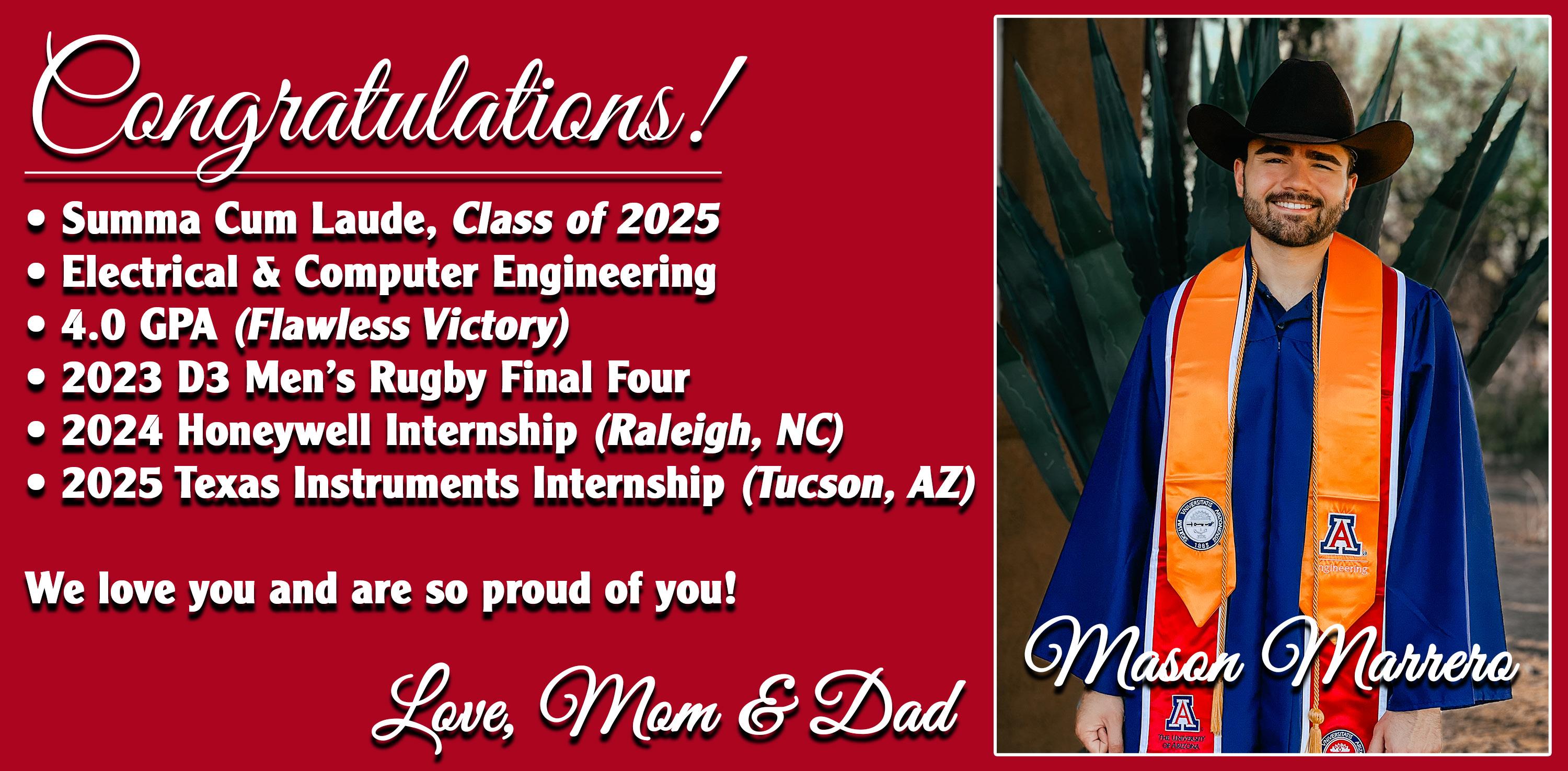ARIZONA ADIEU



SINCE 1899, THE STUDENT VOICE OF THE UNIVERSITY OF ARIZONA & TUCSON • ONLINE, ALL THE TIME, AT WILDCAT.ARIZONA.EDU VOLUME 118 | ISSUE 170 | ARIZONA ADIEU 2025
INSIDE: Senior farewells | Student leaders on campus | Battle of the Bands | Sports season recaps
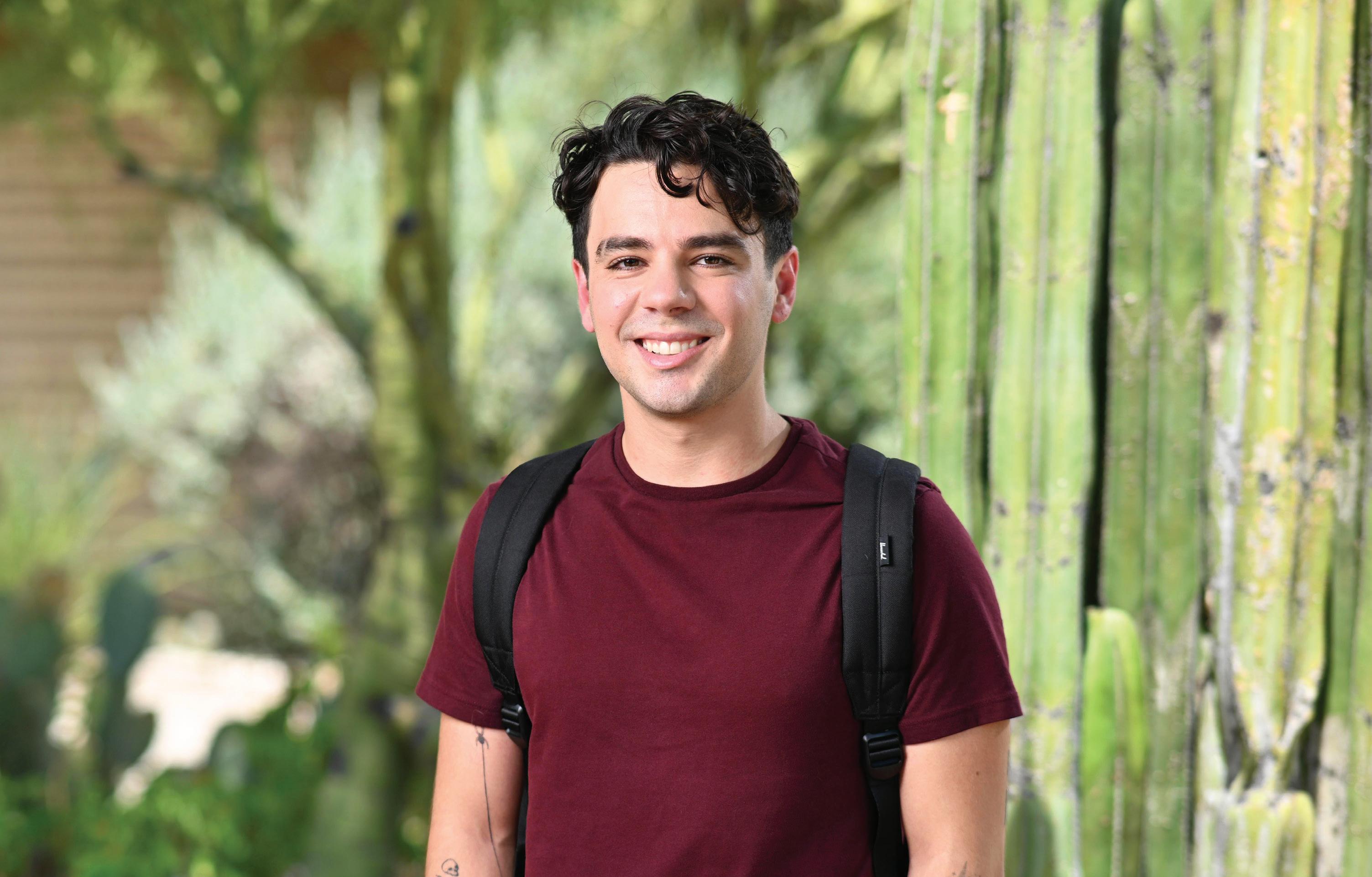
“After dropping out of high school, I returned to school as a Computer Science major to support my family. Earn to Learn and Hughes taught me to be responsible with my money and plan for my future.
Learning about the credit union difference gave me the life goal to never bank anywhere else!” — Hunter C.
Find out how Hughes and Earn to Learn join forces to support student success at HughesFCU.org/ETL

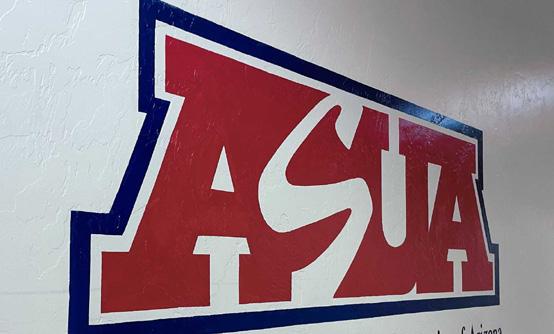

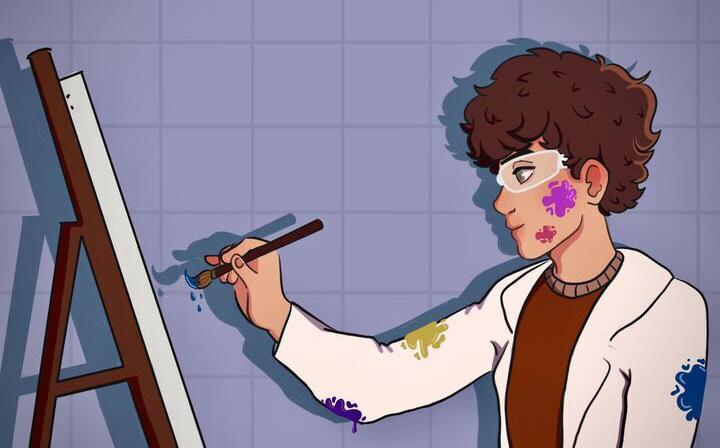
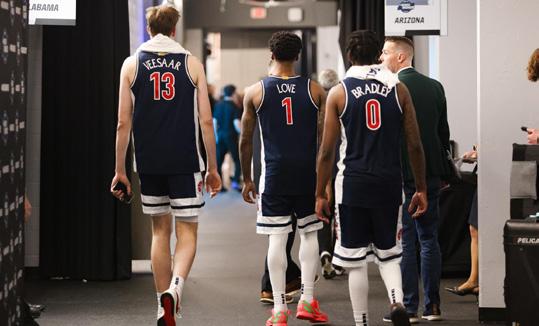

Editor-in-Chief
Sierra Blaser editor@dailywildcat.com
Managing Editor
Sam Parker
News Editors
Sophia Hammer
Kanishka Chinnaraj Emma LaPointe news@dailywildcat.com
Opinions Editor
Luke Lawson opinion@dailywildcat.com
Editing Staff
Sports Editors Melisa Guzeloglu Reed Lofstedt sports@dailywildcat.com
Arts & Life Editors Sabina Hernandez arts@dailywildcat.com
Photo/Multimedia Editors Jay Corella Mason Kumet photo@dailywildcat.com
Copy Chiefs
Ari Keating Olivia Volland copy@dailywildcat.com
Comics Editor
Sela Margalit smargalit@dailywildcat.com
Social Media Coordinators
Nandini Manepalli Kiara Adams socials@dailywildcat.com
Designers
Sam Parker
Sierra Blaser
Sela Margalit
Jay Corella
Mason Kumet
Emma LaPointe
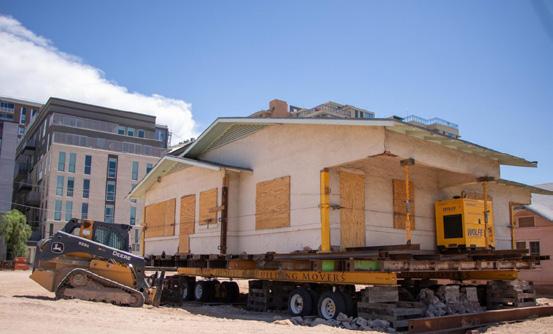
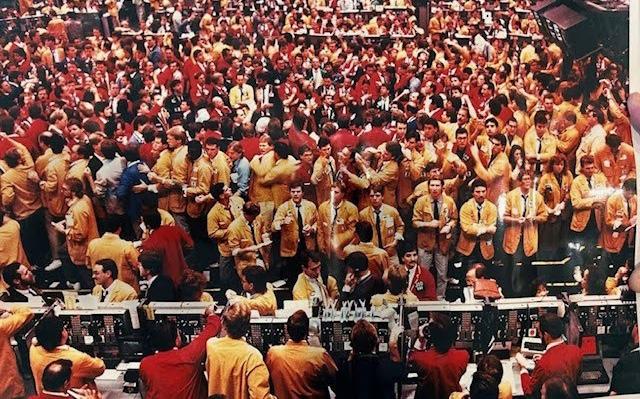
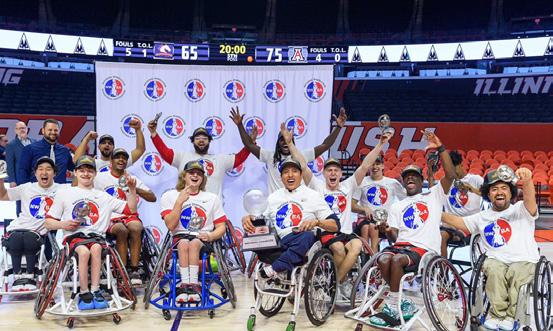
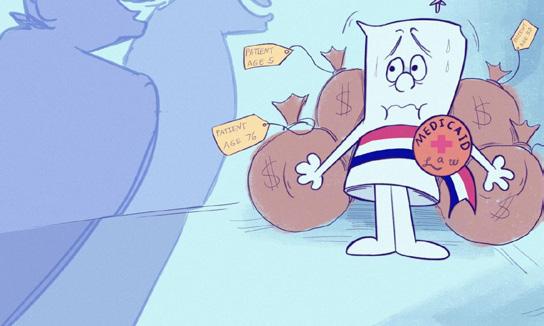

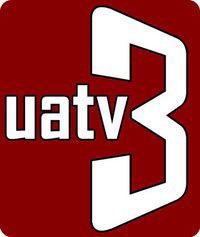
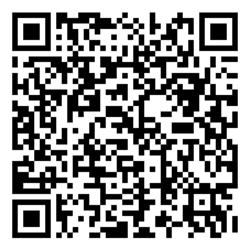

NOOR HAGHIGHI Former Editor-in-Chief
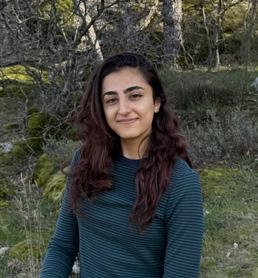
“Join a club,” they said. “Play a sport,” they said. So I searched and I pondered. I attended club fairs and talked to my counselors; still, nothing quite stood out to me. But one day I got an email from the Daily Wildcat and while it seemed intimidating, the thought crossed my mind to reach out. It couldn’t hurt. Since then, I have not only been able to develop my career in journalism, but have also used the Wildcat as
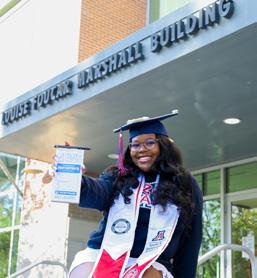
As I say goodbye to the Daily Wildcat and all that it has given me in my 4 years of working for it, I can’t help but feel an overwhelming sense of gratitude for all this paper has given me.
Having served as a news reporter, assistant news editor and now social media coordinator, the skills I have gained and people I have met I will take with me far after graduation. It makes me so happy to know that I spent my college years contributing to this paper that has broken countless stories and been a part of campus since 1899. For the last time as a part of the Daily Wildcat staff, Bear Down!
a mechanism for personal growth and a sense of community. I’ve come a long way from my first article draft (which never saw the light of day by the way) thanks to this organization. And I’m so thankful to have built relationships with some of the most interesting, funny and compassionate people out there. I wish I could stay on the photo desk forever, shooting from the floor in McKale Center, following the parade route on Bear Down Fridays and reminding the photographers to return gear to the newsroom. It’s been a joy to be part of this for a short period of time and I can’t wait to see where the next reporters take it.

The Daily Wildcat has been one of the most rewarding experiences of my undergraduate career, from joining the news desk as a reporter my sophomore year to completing my time at the university as the news editor. This organization has equipped me with valuable journalism skills, given me the opportunity to interview individuals from faculty to political leaders within the Tucson community and a platform to write articles translating complex public health and scientific topics for the general public. I would like to express my gratitude to our wonderful news desk as they are the reason why this journey has been both enjoyable and memorable. I will continue to write post graduation and am excited for our team member’s bright futures!
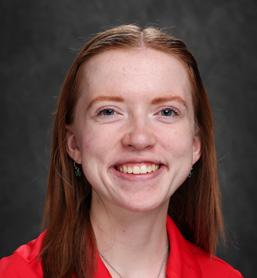
I’ve never been good at saying goodbyes, whether they to be to cherished people, places or things in my life. The Daily Wildcat, where I have spent the last 4 years of my life growing, learning and building friendships that will last a lifetime, is no exception.
I don’t think I can ever properly express my gratitude for this organization and the people within it. Freshman-year Sam sure made a lot of mistakes, but one thing she did right was taking a chance on applying to join this team. I have
REED LOFSTEDT Sports Editor

My time at the Daily Wildcat has not only prepared me for the future as a career journalist but also helped me expand my knowledge and journalistic focus. My start at the Daily Wildcat allowed me to explore sports in a whole new way. I was able to cover sports that I have had a deep connection with, such as football and basketball, while also exploring niche sports like club or adaptive athletics.
From my start all the way back in fall of 2023, I learned under some of the best editors like Mason Duhon, Jason Dayee, Nate Stenchever and Melisa Guzeloglu. I couldn’t thank them enough for putting me where I am today. Mason was my first editor and he introduced me to covering hockey for the desk and this really grew my drive for sports journal-
learned some of the most valuable lessons and gained some of the most valuable relationships in my time at this publication. I will dearly miss the late nights of coverage, long weeks of print design, surprisingly competitive game nights, potlucks and more that have so enhanced my college experience.
I’ve never been the best at saying goodbyes, but I can recognize how incredibly privileged I am to belong to such an amazing group of people that makes saying farewell so challenging. I know that my friends at the Wildcat will continue to do amazing work, and I am so proud to have been a part of this organization throughout college.
ism. I am extremely grateful for such experiences like traveling to Seattle, Washington for March Madness with our amazing staff.
My experiences here have shaped me into the person I am today and the person I plan on being as a journalist. My time as assistant editor has allowed me to aid reporters and help shape our desk into the best possible news outlet we can be for Arizona fans and overall sports fans alike. This opportunity with the desk we have has brought me nothing but joy when covering games. I want to take my experiences here to continue to create the best content I can while also creating a community within the desk and paper where I end up going.
I greatly appreciate the chances given to me by other staff at the Daily Wildcat and I hope to utilize these experiences fully for my career ahead.
LUKE LAWSON Opinions Editor

During my last 3 years at the Daily Wildcat, I have learned and grown more than I could have imagined. As an accounting major, I don’t spend much time researching or writing, and the Wildcat provided me with the opportunity to step out of my comfort zone, do something different and improve both of these skills. Being a part of the opinions desk allowed me to build connections and a family with a diverse group of people who have amazing ideas and perspectives. Seeing the brief removal of the desk through before its return also inspired another passion of always creating a space for people to express their voices and ideas, and I will take this passion with me after graduation. Opinions are important, and this desk will always stand as an outlet for student voices. Serving as the opinions editor for the last two semesters has been an incredible honor, and I will take the time I have had here with me as I start the next chapter in my story.

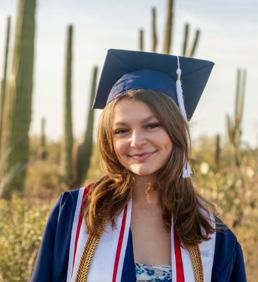
SOPHIA HAMMER News Editor
Joining the Daily Wildcat and eventually becoming the news editor was one of the most formative experiences of my college career. This newspaper taught me the value of storytelling, and not just reporting facts, but giving voice to people and issues that may go unheard. I really enjoyed covering student protests, university changes, breaking news and local Tucson politics. I want to especially thank the news desk this year. The team I had the privilege of working with was smart, driven and deeply committed to telling important stories. They make me hopeful for the future of reporting. I know they’ll all continue to share their amazing work whether that be at the Wildcat or elsewhere.
SABINA HERNANDEZ Arts & Life Editor
Hello Wildcats!
This will be my last semester as a member of the Daily Wildcat . Over the years, I’ve had the privilege to grow and learn through my roles as a news reporter and Arts & Life editor.
I want to thank everyone I’ve had the opportunity to work with, as well as the University of Arizona students who picked up our print editions or read our stories online.
I’ll truly miss getting to know more about Tucson and the university with every new pitch. I’m incredibly grateful for everything this experience has taught me, and I’ll carry that knowledge with me as I pursue my future aspirations in journalism. Thank you and goodbye!
JAY CORELLA Photo Editor
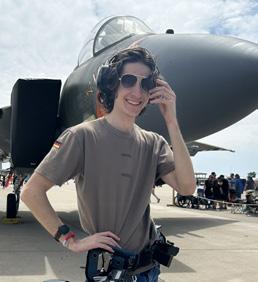
My tenure with the Wildcat was incredibly short compared to my peers, only being on staff for 2 years and being an editor for only a year. In that time, I have had some of my best experiences in college. I’ve been able to shoot events that I would have never even thought were possible to get into, meet some of the best people to work with and most importantly, improve immensely as a shooter.
Leaving the Wildcat will be a sad reality, but being able to be a part of it in the first place has been an immensely meaningful experience and I will carry the memories I’ve made here forever.
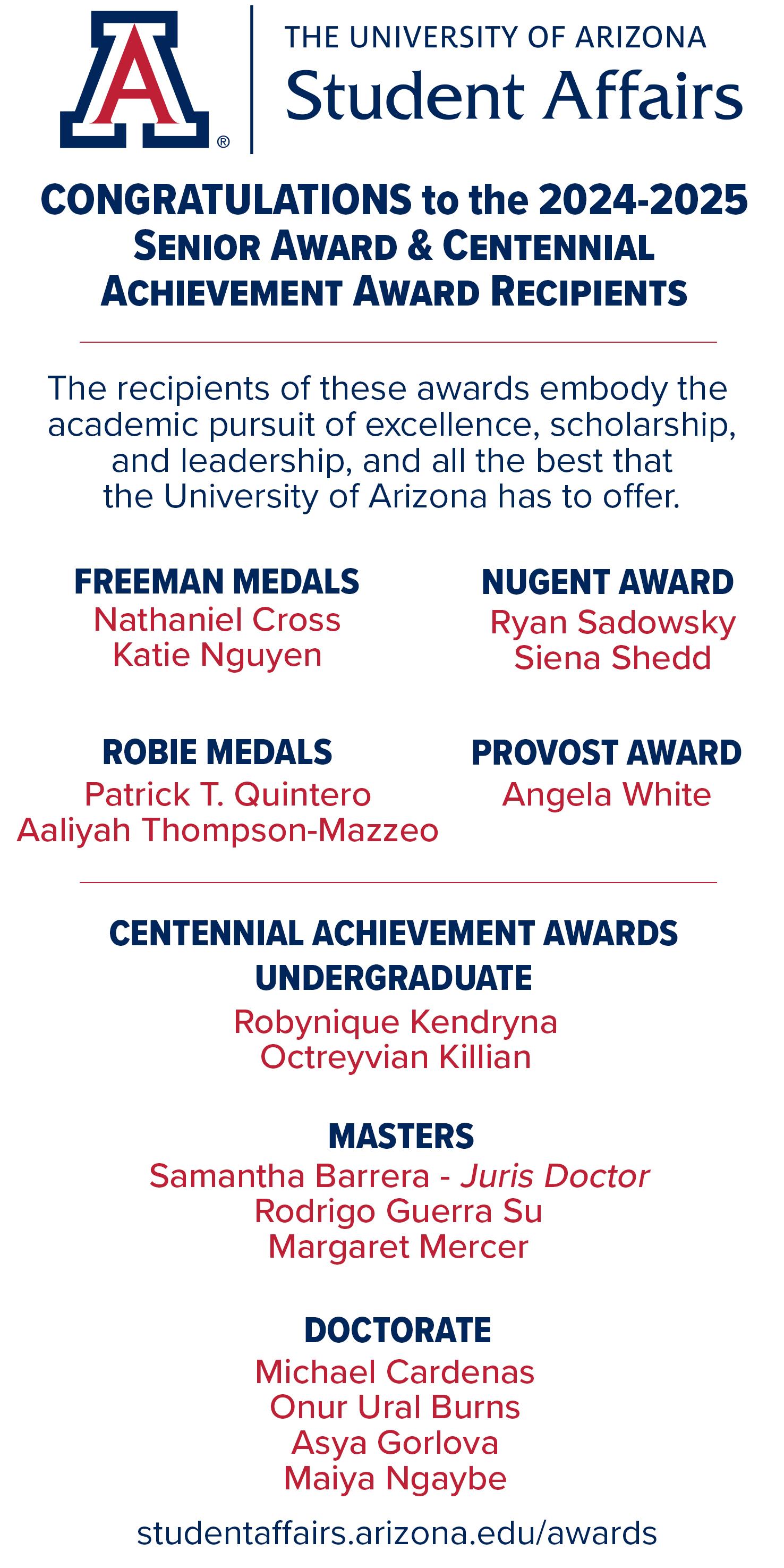
BY EMMA MCDONOUGH
The Daily Wildcat
As they prepare to lead the student body through the upcoming academic year, the newly elected executive team of the Associated Students of the University of Arizona met on April 15 to share their vision for building trust, increasing visibility and creating meaningful relationships across campus.
Incoming Student Body President Adriana Grijalva, Executive Vice President-elect Benjamin Huffman and Administrative Vice President-elect Katie Kelliher sat down to discuss their plans, priorities and hopes for their 2025–2026 terms. According to Grijalva, their top three priorities for next year are communication and transparency, building a strong Wildcat community and supporting student needs, such as mental health, safety and affordability.
In terms of communication and transparency, Kelliher referenced her goal to bring students into the behind-thescenes processes of projects rather than simply display the final product. Additionally, Grijalva expressed wanting to give students more of a voice in forums with the university administration.
“There’s a lot of decisions that get made at a state level or at an administrative level and students are constantly asking how that impacts our college and how they can change those things,” Huffman said.
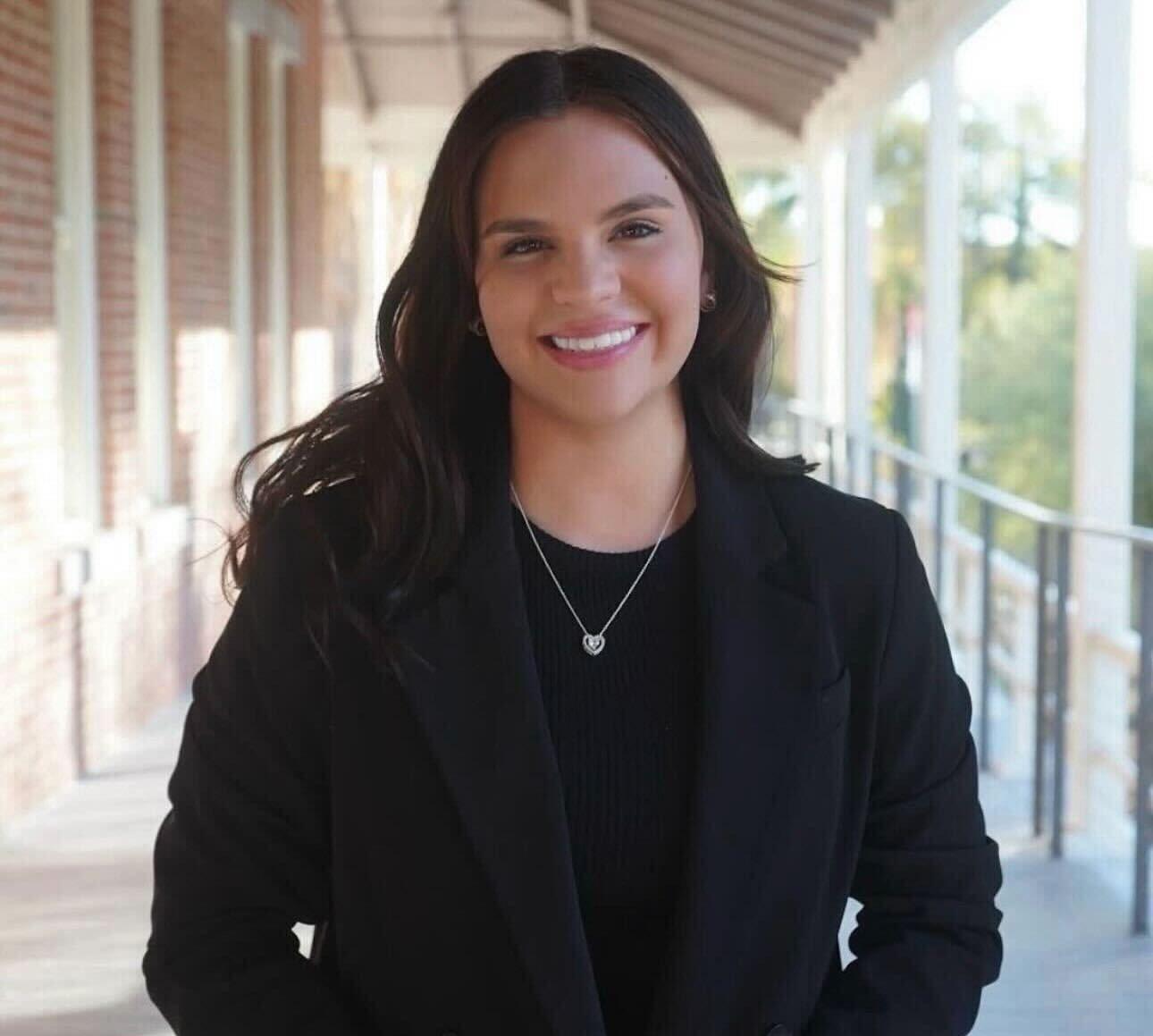
Huffman then raised concerns about the disconnect between the UA administration and students. He explained that the administration is aware of generalized student concerns, but often doesn’t see how severe or widespread those issues are.
Huffman acknowledged that some progress has been made, but pointed out that it’s happening at a distance — separate from the real experiences of students. To Huffman, ASUA’s role is to bridge that gap by bringing administrative decisions closer to the realities of student life.
“We have to be just as eager to work with them as they are with us, so we need to find common ground,” Huffman said.
Grijalva then outlined her goal to expand the marketing efforts of ASUA. She referenced that the executive team’s marketing this past year wasn’t as strong as it could have been.
Grijalva shared that ASUA cannot properly serve as a student government if the vast number of students are not aware of its existence or purpose. She expressed a plan to have more student engagement through tactics like Instagram Reels.
The newly elected executive team is also looking to hire someone to hold more of a presence on the ASUA social media pages. Grijalva detailed that they are looking to have a videographer that can cover ASUA-sponsored events.
Aside from marketing, Grijalva also realized that there are a lot of areas on campus which the student representatives can place more of a focus on. For instance, she wants the new executive team to become more involved in school-sponsored events, clubs, the Greek community and even the housing population on campus.
According to Kelliher, the executive team has a plan to build real relationships with communities on campus that have been historically underrepresented. She expressed that it is their goal to invite collaboration and create feedback channels that feel safe, consistent and culturally responsive.
When asked what a real relationship means, Kelliher said “it just means intentional time, building connections and fostering an environment that is mutually productive.”
Huffman expanded on this.
“We have to be intentional not just about the final product that reaches students, but also throughout the whole process of collaboration,” Huffman said.
“Representation also means taking a hard look at the decisions we’re making,” Kelliher said.
Grijalva echoed her peers’ visions regarding underrepresented communities.
Grijalva and Huffman grew up in the Tucson area, with Kelliher not far away in Sierra Vista, Arizona. This has helped
CONTINUED FROM PAGE 7
them all to have a strong sense of belonging and familiarity with the UA.
“I know what this university can be as somebody who’s been around it a lot longer than I’ve been a student,” Huffman said.
According to Huffman, he also hoped to increase ASUA’s outreach with the larger Tucson community.
Huffman then relayed his rolespecific vision. For the 2025–2026 year, Huffman would like to address the varying needs of clubs on campus. While Huffman recognized the importance of funding initiatives for clubs, he said this isn’t the only issue.
Huffman noted that he wanted to also focus on retention and membership rates of clubs, largely through marketing initiatives. He referenced the importance of clubs to make sure that each student feels safe and their traditions can stay alive.
Huffman will also be in charge of guiding the newly elected ASUA senators through their terms.
“There’s no monopoly on good ideas — they can come from anyone and anywhere. And I trust that these senators were elected and appointed to carry the interests of their students or their college to me,” Huffman said.
According to Kelliher, she would like to implement a clear reporting system to show where ASUA’s resources are going, who’s benefiting from them, where gaps exist and what is going well for the 2025–2026 school year. Kelliher also communicated her want to establish open office hours, feedback loops and forums with student organizations.
“Every individual story informs actiontaking,” Kelliher said.
The future executive team shared that they realized the important qualities in one another.
“I’m very appreciative of this team. We come into it with different experiences, but
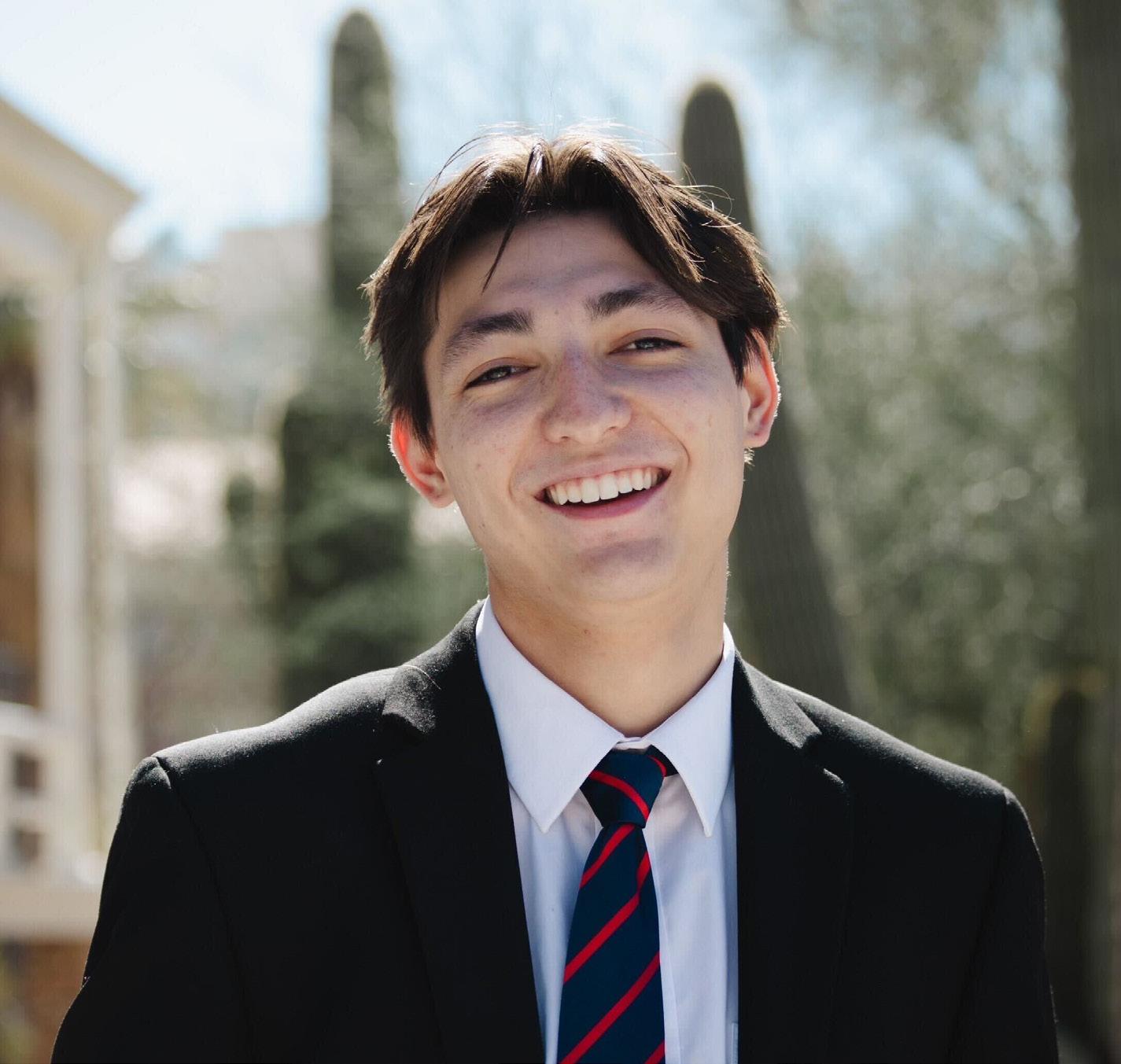

we’re still guided by the same principles of trying to work towards something that is bigger than ourselves,” Huffman said. Kelliher similarly appreciated Grijalva’s and Huffman’s determination.
“It is refreshing to work in a team where there is a commitment to follow through,” Kelliher said.
Huffman also shared the special nature of Grijalva entering her second term as president. He mentioned that it will help the team to enter the next school year on solid footing.
“I feel like coming in a second year has been a blessing in disguise because for this last exec[utive] team, we did not have the best transition, so we are really hoping that this new one can go further,” Grijalva said.
Grijalva expressed how special it was to be going into her second term. She is the first female in ASUA history to be elected for two terms, and the second president ever to achieve this accomplishment.
“We’re in different times than my first term and a lot more difficult times, so it’s great to get a second term, but also a little intimidating,” Grijalva said.
Grijalva explained that when it came to running a second time, it wasn’t an easy decision to make with the amount of hard work and emotional effort it would require. At the end of the day, Grijalva did it because of her connection with her fellow students.
“I would not change it for the world. The people that I get to work with every single day make it worthwhile,” Grijalva said.
While the team is proud of ASUA’s previous progress, they are still looking to the future.
“There is work to be done. There’s progress being made but it would be wrong of us to assume that it’s over,” Kelliher said.
BY RUBY WRAY
Daily Wildcat
With commencement approaching, University of Arizona graduates face the daunting task of finding employment as stock market and tariff fluctuations hold the labor market in limbo.
Pete Corrigan serves students, faculty and employers as the associate director of employer and alumni connections for the Student Engagement and Career Development Center. Before retiring young and moving from Chicago to Tucson with his family, Corrigan was a day trader on the crowded floors of the Chicago Mercantile Exchange.
“People say you can’t time the market,” Corrigan said. “Well, that’s what we did. Traders on the trading floor, whether it was for a minute or a week, you were looking to the future.”
Corrigan shared advice for undergraduate students looking to invest.
“I think a lot of financial advisors tell you to stay in it for the long run, and you can’t argue that they’re wrong,” Corrigan said. “In the long run, the market’s always going to be higher. Historically, that’s been true.”
“But if you sold some things three weeks ago and then sat back with cash and could reinvest it now, you’d have more money,” Corrigan said.
Corrigan began work for the UA at the Eller College of Management as the college’s first career coach. His services were in great demand among students, and Eller now has a career coach for every major.
When Corrrigan started work at SECD, his job was employer relations only.
“But my favorite part is the student advising piece, and I think that you can build relations with employers by introducing them to students,” Corrigan said.
Corrigan began connecting local employers to the students he advised, helping businesses find eager graduates and
students arrange careers after graduation.
Just last year, Corrigan had around 470 individual appointments with students. Students set the agenda and work on resume building, internship connections, interview preparation and starting conversations with potential employers.
“Having worked here 16 years, I know a lot of former students I keep in touch with who are more than happy to talk to students about what they do,” Corrigan said. “And then also I’m building relationships with employers, and employers love referrals.”
Throughout all of his advice, Corrigan stressed the importance of communication.
“I think a big key is talking to people,” Corrigan said. “I mean, if you’re interested in how the market works, talk to people who are involved in the market, and they can tell you about their experience and what’s worked for them.”
“But the only way you can find that out is by talking to people,” Corrigan said. “And I think oftentimes for students that’s painful, because who wants to reach out to someone? But that’s why we’re here.”
Corrigan works on the third floor of the Bartlett Academic Student Success Center, room 301A, and encourages students to schedule a meeting with him and start discussing their plans for the future.
UA junior Diego Morales works at the front desk of the SECD. He’s also one of the hundreds of students Corrigan has helped find an internship.
“Pete [Corrigan] has actually helped me out a lot, and he’s introduced me to some people, and that’s how I’ve gotten two internships so far,” Morales said. He currently interns for Sion Power Corporation.
As a computer science major, Morales recognizes the stress and competitiveness of the career field he’s entering.
“The job market is not great right now, especially for computer science,” Morales said. “There have been a lot of layoffs happening, so that’s definitely a little stressful, but I feel more comfortable now that I’ve gotten internships and gotten that experi-

ence before actually graduating.”
Associate professor of economics Evan Taylor spoke on the current state of national labor.
“The short answer is that the labor market is good but not great,” Taylor said. “Definitely not as good as it was a couple of years ago, right after the pandemic in 2022. The type of job, the salary and what you’re going to be doing vary a lot by the major you have.”
As of Feb. 20, the Federal Reserve Bank of New York released unemployment rates and labor market outcomes of college graduates by major. The rates differ, with the highest unemployment rate at 9.4% for anthropology and the lowest at 0.4% for nutrition sciences.
“With the tariffs and the exemptions of the tariffs, there’s just a ton of uncertainty about what’s happening,” Taylor said.
While the constant levying and elimination of tariffs has had a significant impact on the stock market, Taylor explained that it hasn’t impacted the labor market yet. Within the next six months, he mentioned
it certainly could.
Despite recent market precarity, Taylor doubts that a financial catastrophe like that of 2008-style meltdown is likely to happen anytime soon.
“The two biggest uncertainties related to the labor market are the current tariffs, whether that’s going to cause a recession or not, and AI models are changing very quickly, so it’s hard to say what the cutting-edge AI is going to look like in a year or two,” Taylor said.
Taylor’s advice for students was to become financially literate. He pushed for “learning about how to invest money, how to save, how to budget, even simple things like building up a credit score so that by the time you’re 30, hopefully you can be getting loans to purchase a house.”
“I do wish we did more financial literacy classes, especially in high school,” Taylor said. The UA offers financial literacy events through the Cooperative Extension program and is hosting several sessions from April through May.
BY SOPHIA HAMMER, RUBY WRAY
The Daily Wildcat University of Arizona President Suresh Garimella announced Tuesday, April 8 that starting on Monday, May 19, Patricia Prelock will become the university’s next senior vice president for academic affairs and provost.
Prelock has served as interim president at the University of Vermont since October, where she has also been provost since 2019.
Prelock is one of four candidates that a UA search committee selected to replace Ronald Marx, the current provost and interim senior vice president for academic affairs.
Marx served as interim provost during the 2023-2024 academic year and was reappointed the following year after the resignation of Joe Glover. To introduce the provost candidates, the UA hosted open forums held in person and remotely over Zoom for faculty and staff.
Prelock spoke at her open forum in the Center for Creative Photography on Thursday, March 13. Prelock has worked for the University of Vermont for the past 30 years in several positions.
“I see myself as an institution builder and not a career builder. I go where institutions need me so that I can support their development,” Prelock said.
One way to support development, according to Prelock, was supporting faculty.
“Our students will tell you, they really want a good teacher, so that they can really understand the content, ask questions, and get inspired by what you bring, so I really appreciate our master teachers and that’s always been a huge component of support,” Prelock said.
When asked about protecting DEIArelated practices and resources to support students and faculty, Prelock said, “If you look at the strategic imperatives that President [Suresh] Garimella has set up, the expectations should be success,
academic success, access and affordability for all students. That’s the answer for all students.”
Prelock talked about the importance of leaning into core university values.
“I think we just really have to lean into your values — inclusion, determination, adaption, aspiration — all of those things,” Prelock said.
Prelock explained that one of the reasons she chose to pursue the UA provost position after a long career at the University of Vermont was because of leadership under Garimella, who became the University of Vermont president in 2019.
“Dr. Prelock is a highly accomplished scientist and scholar, clinical speech-language pathologist, and university leader,” Garimella said in an email statement April 8. “As a university leader, Dr. Prelock is known for her focus on the well-being and success of students, faculty, and staff, and she is the ideal person to lead our academic enterprise into the future.”
The UA also recently announced that Amanda Kraus and Chrissy Lieberman, who were both acting in interim roles, now hold permanent positions.
Kraus is now the official vice president for student affairs and Lieberman is now the official dean of students.
Kraus, the new VP for Student Affairs, moved to Tucson for graduate school and earned her master’s and doctorate from the College of Education. She has taught higher education courses at the university for nearly 15 years and was previously the executive director of the Disability Resource Center.
After more than two decades working in student affairs, Kraus now leads the UA’s six student affairs departments: Campus Health and CAPS, Campus Recreation, the Dean of Students Office, the Disability Resource Center, Housing and Residential Life and Student Engagement and Career Development.
Student Engagement and Career Development is a new addition to student affairs, created to connect current and alumni students to career and networking opportunities.
Kraus also explained that student affairs
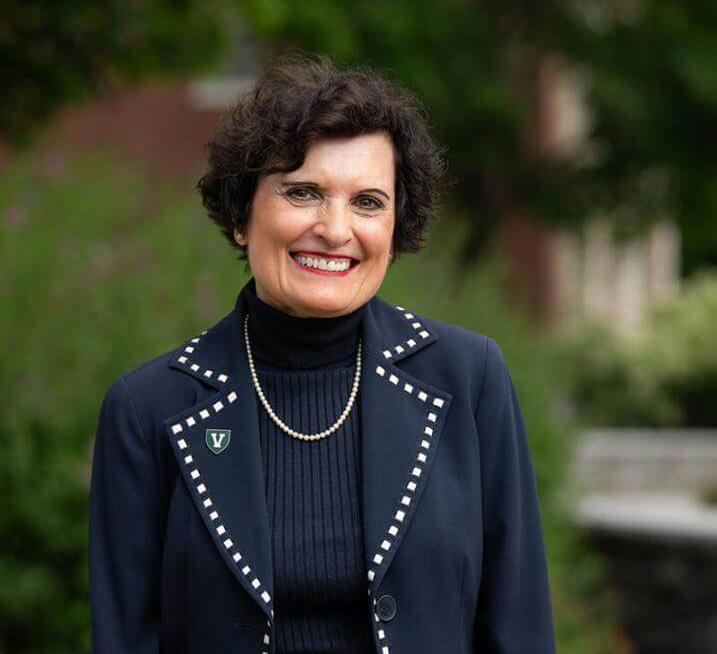
recently had a change in their adaptive athletics program. The program moved from the Disability Resource Center to Campus Recreation. Kraus said the shift was intended to integrate adaptive sports more fully into the university’s broader athletic offerings.
“Campus recreation supports all club sports […] So we thought that is where adaptive athletics and wheelchair sports belong too, not separate in a service office. It is not a special program, these are competitive sports,” Kraus said, “We want to be demonstrating to all of campus that all students belong in the rec.”
In regard to the current federal landscape surrounding DEI and international students, Kraus said the university is still evaluating how to respond to uncertainty around policy, but she understood the confusion and concern that students are facing.
“I want to validate that those emotions are real and understandable, and we are working really hard on how to respond,” Kraus said, “In terms of clarity, I wish I could say something definitive, but I can’t. What I can say is that we are taking this very seriously. We are trying to do the best for the community, for the students, while maintaining necessary compliance.”
Kraus ended with hopes to create more ways for students to give feedback, suggesting town halls and advisory groups.
“I really want to hear from students because I think it is very important for them to be able to voice their opinions, give feedback and know the person they’re delivering the feedback to. I would like to make myself available to students,” Kraus said.
JAY CORELLA
The Daily Wildcat
On April 5, models strutted down the runway during the University of Arizona TREND’s third annual UA Fashion Week on the roof of the Hub on Park Avenue. The show included the designs of nine local designers all centered around the theme of Arizona-inspired resort wear. The rooftop runway saw models walk around the Hub’s roof showing off bold and unique outfits.




JOSIE SHIVERS
Daily Wildcat
Students at the University of Arizona enjoyed Battle of the Bands on April 17. Bands such as Silveretta, Znora, Desert Child, Skin Theory and The Hawthorne Experience were featured. Students got to enjoy listening to each band and they could also enjoy free food, hat decorating and a photo booth. The students, near the end of the event, got to scan a code where they could vote for what bands they liked best. The band that gets the most votes gets to perform at Bear Down Music Festival.
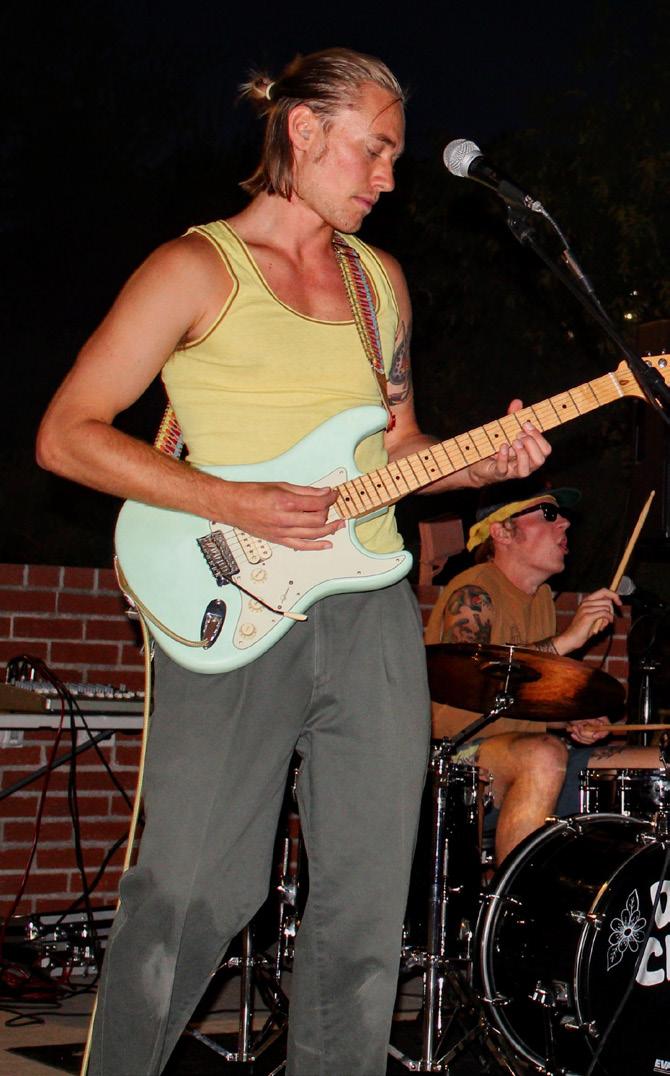
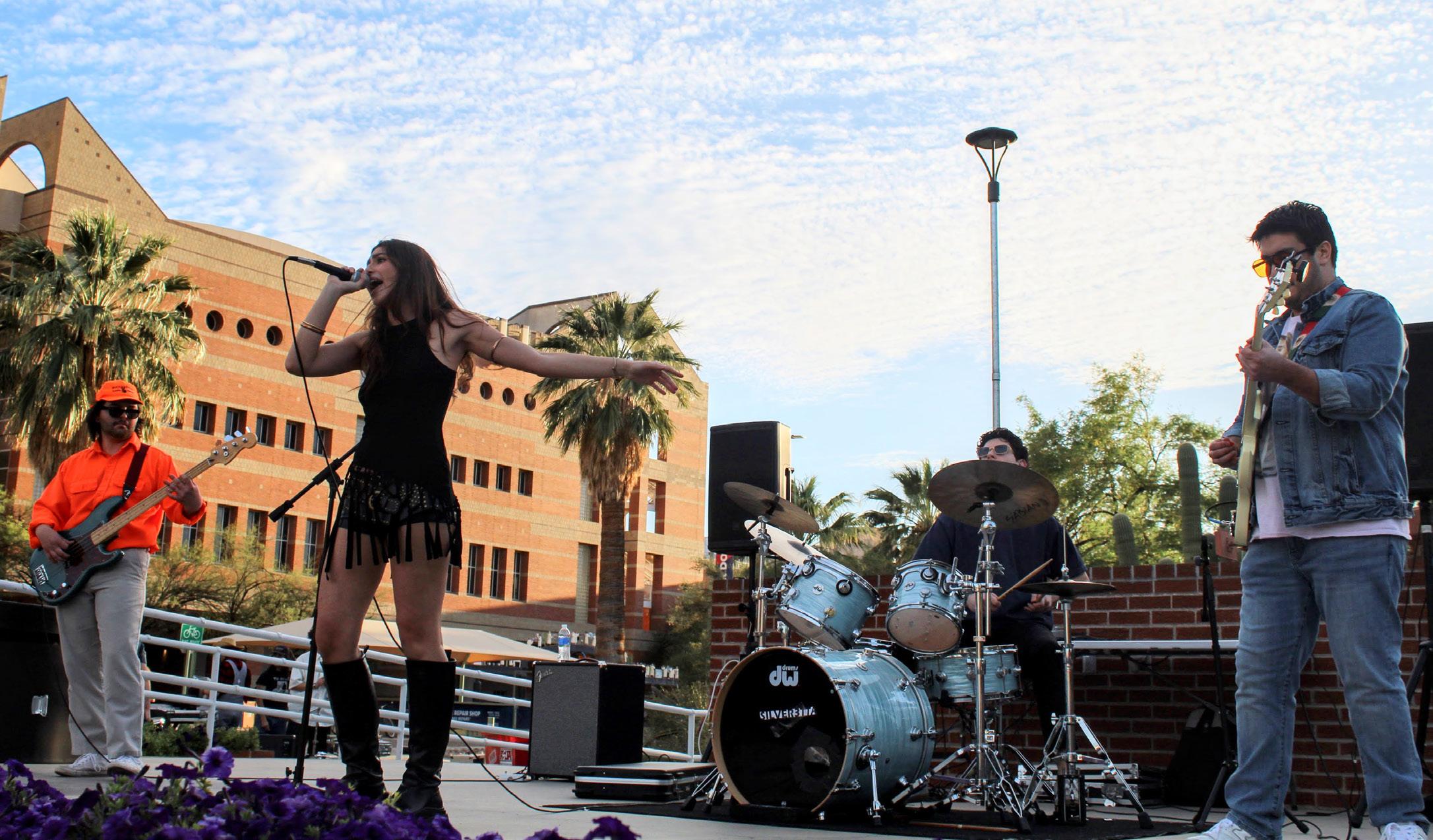
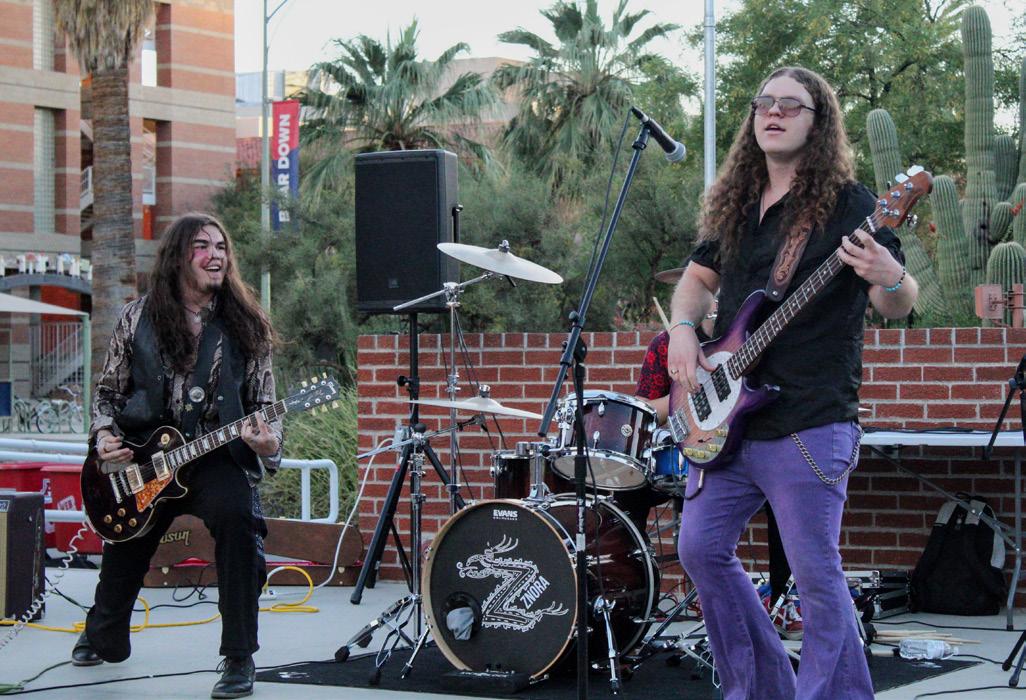
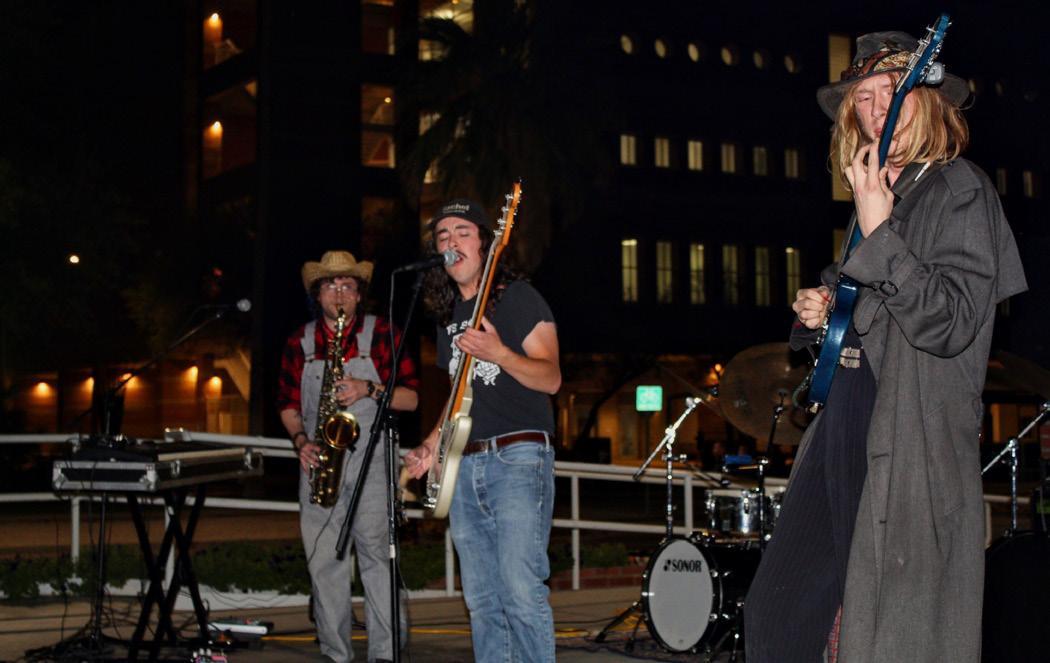

BY FIONA SIEVERT
The Daily Wildcat
A few months ago, I attended a public panel and reception at the Center for Creative Photography. The artists in attendance discussed how their work was the product of months — or even years or lifespans — of detailed and critical examination of self and society. I was reminded, once again, that art really is research.
Yet some types of research receive more funding than others.
As a graduating student in the College of Humanities and the College of Social & Behavioral Sciences, I am not part of the art department but even I feel the funding shortage. When I talk to my peers in engineering, for instance, I learn about the plethora of opportunities for travel and research afforded to them by their department. All-expenses-paid trips to other countries are not unusual and lavish annual career fairs are an established norm. Meanwhile, my anthropology professor can’t get the funding to feature occasional guest speakers in class.
The recent federal funding cuts for science research are perhaps the first time that I have heard about a cash shortage or funding struggles for scientists. For years, the stories that I heard from professors and researchers here at the University of Arizona was that there was more money in science research than they knew what to do with. At times, it was a struggle to spend excess money before the end of a grant period.
I have never understood why our higher institutions feel so inclined to fund research led by the sciences, while completely overlooking the value of knowledge generated by artists, thinkers and creators. Don’t get me wrong: funding science research is extremely important and I do not support the recent funding cuts. At the same time, I am reminded that scientific research has always been comparatively well-funded.
As an anthropology student, I spend time thinking about how humans create meaning and what forms of meaning and knowledge production are most valued by societal institutions. The term research is often used to refer to a needle-thin subset of the kind of

learning and knowledge production that actually takes place all around us. If we were to expand this definition, other ways of knowing that do not align as well with the established Eurocentric scientific processes might have a chance to step into the spotlight as well.
In the case of art, each piece contains the cumulative knowledge of its artist. This includes not only their technical training — how to hold a brush or how to create a certain effect — but also their understanding of personal identity and the process of learning about that identity. Not all art examines the self; sometimes it examines others. This kind of work might produce experiential knowledge about social boundaries, building intercultural connec-
tions, creating community, educating — the list is practically endless. Still, other art does not even produce a final product for display but simply involves community and collaboration within a small circle. Other art is shared online and reaches millions. There is nothing that art cannot explore, nothing that the artist cannot research and nobody that art cannot reach.
In many ways, scientific research as we know it is more limited. It is bound by the scientific process. There are pressures which might lead research to becoming dishonest or rushed. In the end, the research paper produced might be so riddled with lingo that the average person might not understand it anyway.
My intention is not to place art research
above scientific research, only to challenge the idea that one deserves funding more than the other. We need both kinds of research to develop a complete understanding of our world — but right now it feels like one is considered the foundation of modern society and a worthy career, while the other is viewed as a hobby or a side-gig with little practical bearing on our lives.
The truth is that artists, like scientists, have the capacity to investigate a topic and contribute new conclusions about ourselves and the world to the collective consciousness. As I graduate from the University of Arizona this May, I can only hope that the new president understands this — and acts on it.

Student Affairs wants to recognize the incredible contributions our student employees from the Class of 2025 have made. We honor you and celebrate your future success.
Aaron Stenzel
Abigail Doyle
Addysen Awad
Ainsley Martinez
Ainsley Sullivan
Ainsley Thomas
Airen Fortunato
AJ Michael
Alexander Hale
Alexis Carreon
Alexis Rylaarsdam
Alia Nichols
Alicia Hall
Aliya Lisle
Alyssa Fellows
Alyssa Nan
Alysse Avila
Amanda Goldman
Amaya Ramos
Amber Blossom
Anabella Valdez
Andrea Riva
Andrew Kwolek
Andrew William
Muyanja Jr.
Angelina Fusitua
Ani Georgian
Anthony Diozzi
Anthony Nguyen
Arianna Velosa
Arjin Phull
Arjun Taluja
Aryanna Lozano
Ashley Mentor
Ashley Schutte
Audrey Brown
Audrey Lockman
Ayanna Mergerson
Ayden DaCosta
Barbara Drejza
Bella Adams
Bella Lopez
Ben Black
Benjamin Jackson
Bennett Smith
BenWallace
Bode Newell
Braden Hoffman-Diaz
Brandolyn Baeza
Brendan Oshima

Breyton Whitehead
Brooke Alexander
Caleb Charles
Caledonia Yeager
Carley Shotsman
Carolyn Nuss
Cherish Franklin
Chinle Reinshagen
Chloé Barefield
Chloe Wilcox
Christian Viramontes
Christina Acosta
Christina Chavez
Christopher Reid
Christy Tran
Claire Pickett
Claire Warner
Claudette Rubio
Cole Roberson
Cole Withers
Colin Hanley
Colleen Robinson
Colton Mealer
Cooper Mauldin
Cruz Ramirez-Ramos
Daniel Noriega
Daniel Nystedt
Dante Fadelli
Dante Mienie
David Rosenblatt
Dayanara Hernandez
Desbah White
Destiny Rivera
Devin Boyle
Devyn Nelson
Doodle Berglund
Dorie Chen
Drew Cottingham
Dustin Stallberg
Dylan Belli
Elana Goldberg
Eli Bauer
Eliana Kelly
ElizabethWilson
Elle Nicholson
Elyse Browning
Elyssa Stein
Emaad Qureshi
Emily Hartzler
Emily Ryon
Emily Schorr
Emma Diana Wong
Emma Hutchinson
Emma Miller
Enka Hysaj
Eric Rodriguez
Erika Dewey
Erin Puskas
Esperanza Valencia
Eston Brauer
Ethan Burnett Nguyen
Ethan McNew
Ethan Rothfeld
Evya Sivarajan
Eyad Amin
Fabiana Damir
Gabriella Cartier
Gabriella Venegas
Gavin Vetro
Genessa Ziegler
Gianna Rossini
Ginger Crow-
Grace Katherine Goveia
Grace Uso
Grady Campbell
Greatness Ojum
Grecia Chavira
Hadley Poeppel
Hailey Toth
Haley Fenolio
Hanna Lawson
Hannah Kempen
Hannah Pawlowski
Hannah Shealy
Harris Hamilton
Hayden Wisneski
Hesus Chaparro Oramas
Holly Sutter
Isaac Hernandez
Isaac Rodriguez
Isabella Bonham
Isabella Wilson
Isabella Winiker
Isabelle Carmedy
Jack Coleman
Jacob Fink
Jacquelyne (Jacky)
Talavera
Jadyn Sherry
Jaiden Culberson

Jake Friedman
Jakob Buckley
Jase Colson
Jasmin Alvarez
Jasmin Hayes
Jasmine EyssallenneCook
Jasmine Tafolla
Javier Hernandez
Jayden Albertie
Jazzmine Ward
Jenna Heavner
Jillian Bantz
Jocelyn James
John Moore
Johnna Zarndt-Buettner
Jorge Villaescusa
Josh Villanueva
Joshua Gonzalez
Juan Serrano
Julia Herrera
Julia Schaefer
Julie Polovitch
Kaiea Orr
Kaitlin Mack
Kaitlyn McKnight
Kaley McHaffie
Katelyn Chhuon
Kathryn Dunham
Kathy Nunez
Kendall Dale
Kenneth Tanaka
Khesly Uwatubambiwe
Kristen Gunter
Kyle Kressler
Kyle Paulding
Lauren Anderson
Lauren O'Callaghan
Lester Berrios Cortes
Liam Gallagher
Liliana Quiroz
Lilly Arthur
Lily Finnegan
Lindsey Frenia
Logan Rhodes
London Wood
Lucinda Valentine
Luis A. Felix
Lyn Etori
Lyndee Tyers

Macey McGraw
Mackenzie Anderson
Maddy Kogachi
Madeline Boose
Madison Grams
Madison Hernandez
Madison Rutherford
Madison Speer
Manny Lagarda
Maria Joaquin Boquila
Mark Rodriguez
Mason Maynard
Matt Moriarty
Matthew Mekari
Matthew Nguyen
Maya Bruley
Maya Holmstrom
Maya Kostov
Meadow Morrell
Meena Caputo
Meena Caputo
Melissa Buchanan
Micaela Nasrah
Miguel Perez
Mimi Mcvey
MK Fairbanks
Molly Monheit
Molly Peebles
Morgan McGurk
Morgan Yadron
Murphy Berglund
Natalie Dafoe
Natalie Sanchez
Natasha Mattos
Nate Robinson
Nathaniel Skiffington
Nevaeh Esquivel
Nguyen (Tom) Pham
Nicholas Ribas
Niko Martell
Obi Blossom
Olivia Cavazos
Olivia Flaker
Olivia Hajdys
Olivia Krupp
Olivia Snyder
Pacific Smiley
Paige Keller
Paige Mcdougall
Paige Wagstaff

Pamela Salcido
Paola Mendivil
Paulina Garcia
Peyton Johnson
Piper Klein
Preston Connolly
Quinn Sauer
Rachel Benincasa
Rachel Rhomberg
Rachel Yocum
Raheemat Alade
Raksha Tabada
Rebecca Jacob
Richard Railey
Riley Cleveland
Riley Weber
Robynique Kendryna
Roman Sharp
Rory Bates
Ryan Bullard
Rylee Gardner Dunkin
Sadelle Gibson
Sadie Goldman
Saira Khan
Sam Hemstreet
Sam Stuckey
Samantha Araya
Sarah Twombly
Saranya Madhira
Sasha Neyman
Sean Rodmel
Seth Berkowitz
Shaina Begelman
Shannon McGuire
Shelby Janssen
Sidney Montgomery
Sienna Slony
Simi Saha
Simon VanHoute
Sofia Kidd
Sophia Della Croce
Sophia Rose Chirco
Sophie Dial
Srikar Kollipara
Sue Kwon
Sydney Carpenter
Sydney Schumer
Sydrah Damir
Sylvia Bruzga
Talia Tardogno

Tanner Valus
Teagan Pahl
Teryance Horace
Tiffany Edwards
Tim Brandenberger
Uma Kirchler
Valerie Cruz
West Maddox
Will Collins
Ximena Sanchez Mejia
Zachary Kosmerchock
Zahraa Adnan
Zorina Winters
Graduate Students
Abigail Hopper
Agastya Deshraju
Anais Ruiz
Blaise Mutware
Breeanna Wolkerstorfer
Brittany Grantham
Danielle Norris
Elijah Greenfield
Emily Ruiz
Gabe Madrid
Glory Adeyemo
Jocelyn Garcia
Juliette Rico
Kaarthik Patibandla
Kemper Brightman
Lauren Pizzino
Monique Thomas
Nana Adwoa Amoh-Asante
Nicholas Marcell
Ryan Mitstifer
Tejas Bhawari

BY REED LOFSTEDT
The Daily Wildcat
The No. 1 University of Arizona men’s wheelchair basketball team (28-4) dominated the No. 2 University of Texas, Arlington 75-65 on Saturday, March 29, in the State Farm Center in Champaign, Illinois. Arizona waltzed its way through the National Intercollegiate Wheelchair Basketball Tournament, defeating the likes of No. 8 Edinboro University and No. 5 Southwest Minnesota State University.
This was the Wildcats’ third straight time in the NIWBT National Championship game and this year they were finally able to capture the elusive title behind some big-time performances.
Three Wildcats finished the game in double digits with Justyn Newman leading the helm with 26 points. Dylan Zander followed, putting up 24 points and seven assists while Brandon Louie finished with 12 points. Despite 3-pointers being limited in the match, with the Wildcats attempting a postseason low of 6, Arizona was able to shoot 47.6% from the field, 30-of-63, to control their advantage.
Despite having a rough shooting night, Arizona’s Blaise Mutware excelled in steals. Mutware more than doubled Texas’ postseason high of four by recording a 10-steal game against UTA. He also provided as a key aid for the Wildcats, putting up team game-highs in blocks and rebounds, with two and eight, respectively.
The Wildcats came into the postseason riding a massive 11-game winning streak, with notable wins including a 36-point win over the No. 7 University of Wisconsin, Whitewater, on Feb. 8, an 84-69 revenge win over No. 4 Auburn University and two 20+ point wins over No. 2 UTA. Newman, the 2024–2025 National Championship MVP and 2023 NIWBA Player of the Year, has been electric for
the Wildcats in the postseason. Newman averaged a combined 27 points, 7.7 assists and five rebounds per game. His best outing came in the tournament’s second round against No. 5 SMSU, where the senior dropped 30 points on 12-for-22 shooting from the field, alongside 12 assists and two steals. In the National Championship, Newman posted 26 points, with seven assists and a personal postseason high of seven rebounds.
Arizona proved their skill and came to play, maintaining a strong lead in the end of the third quarter that would send them to victory.
First half
Arizona’s Zander would get the scoring started with a mid-range shot that would start the Wildcats’ opening 6-0 scoring run. Mutware would be crucial in this start as well, collecting a steal and a pass for Ben Thornton to score, followed by a lay-in of his own.
UTA came back on its end with two layins to cut the lead to 6-4. This was followed by several back-and-forth possessions with Arizona and UTA players both trading shots. The Wildcats caught fire once again, going on another 6-0 scoring run, capped off by Zander and Newman hitting shots from beyond the arc.
The Wildcats were then held scoreless from the field for nearly 4 minutes of play, with their only point coming from Newman’s single shot at the free-throw line. Despite this, Arizona ended the first quarter with a last-minute shot taken by Louie to take the 23-14 lead.
To open the second quarter, Arizona’s offense would stagnate, allowing the Movin’ Mavs to close the score gap to 23-20. Continuing on the slow start, Arizona scored only 4 points in the first half of the second quarter compared to UTA’s 8. Despite a late push by Newman nailing in a shot, the Mavericks crawled their way back to make it a 1-point game in the final minute. However, on the other end, Louie found an open shot in the paint to keep the Mavericks at bay.
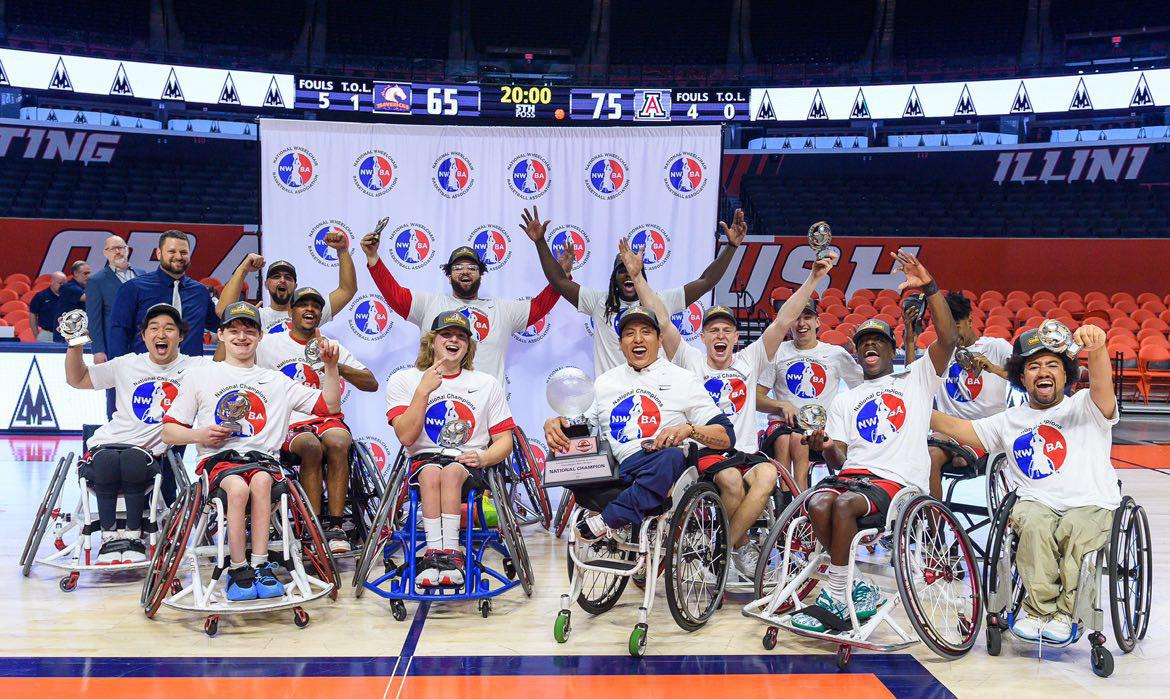
This allowed Arizona to go into the half leading UTA 35-32.
Second half
Arizona’s early first quarter advantage withered away as the Mavericks scored 18 points over Arizona’s 12 in the second half. Both programs continued to trade possessions back and forth. Despite Zander hitting crucial shots for the Wildcats, UTA did not trail too far behind, bringing the deficit to a narrow 39-38 after two made free throws.
With the game remaining at a neck-andneck score, UTA eventually took a 5-point lead over the Wildcats. Arizona wouldn’t let this advantage last long, as Newman and Louie hit back-to-back shots to gain the 49-46 lead back. Arizona ended the third quarter on a made shot from Zander that kept the Wildcats ahead, 51-48.
Arizona opened the final quarter going on a huge 10-0 scoring run that saw Louie find two crucial shots from mid-range and a lay-in. Newman secured two free-throws and a mid-range shot and Zander kept it going with another layup to top off the run. Despite UTA looking to erase the growing lead with a trip to the line, Zander came right back to keep the game in the hands of
the Wildcats, 63-50. With under a minute and a half remaining, the Movin’ Mavs looked to push the Wildcats, scoring two straight possessions and cutting the lead to single digits at 67-58. Despite the limited amount of time left on the clock, the two programs put up a combined 15 points in the remaining 2 minutes of the quarter, with Arizona putting up 8 to clinch the championship. After multiple trips to the free-throw line, the Wildcats stopped any resurgence of a UTA comeback, sealing the win 75-65.
Donning NIWBT Championship shirts and hats, the team hoisted the title that had eluded them the last 3 years. Posed with awards in hand, assistant head coach Jose Maravilla was the one to hold up the championship trophy for photos. Newman was awarded the championship MVP moments after, spinning the golden ball signifying his importance to the championship team. Mutware cut down the all-important net, enshrining the Wildcats in NIWBT history.
BY MELISA GUZELOGLU, ELLIE CONOVER
The Daily Wildcat
The University of Arizona men’s basketball team concluded its first season in the Big 12 conference and has wrapped up its 2024–2025 season. With a season that began with a disappointing 4-5 start, the Wildcats clawed their way to a 24-13 overall record and 14-6 conference record. Arizona made it as far as the Big 12 Championship title game, where the Wildcats ultimately fell 72-64 to the No. 1 University of Houston in Kansas City, Missouri. During the NCAA tournament, Arizona saw the Sweet 16 after making it past the first two rounds, ultimately collapsing to Duke University in a 100-93 loss to close out the season.
The returning roster from the 20232024 season included seniors Caleb Love, Liam Lloyd, Will Menaugh, Grant Weitman and Luke Champion. Aside from the graduating class, other returning players included Henri Veesaar, Jaden Bradley, KJ Lewis, Will Kuykendall, Motiejus Krivas, Jackson Cook and Conrad Martinez. Arizona also incorporated new players ranging from freshman class to transfers from the portal. These new additions included players like Trey Townsend, Tobe Awaka, Carter Bryant, Anthony Dell’Orso, Addison Arnold, Emmanuel Stephen and Sven Djopmo.
Regular season recap
The Wildcats opened their preseason games with a 4-2 record, securing dominant victories over Eastern New Mexico University, Point Loma Nazarene University, Canisius University and Old Dominion University. On Nov. 15, 2024, Arizona faced the University of Wisconsin, earning their first loss 103-88. Days later, the Wildcats suffered their second defeat of the season on Nov. 22, 2024 to Duke University at home, whom they saw only once more in the NCAA tournament.
Once Arizona’s pre-conference games wrapped up, they headed to the Bahamas to compete in the Battle 4 Atlantis tournament, which ran from Nov. 27-29, 2024. They secured a 104-71 victory over Davidson College in their first match but fell to the University of Oklahoma and West Virginia University in their final two games.
Despite coming off several losses in
early-season games, the Wildcats impressed with a 102-66 win over Southern Utah University on Dec. 7, 2024. Dell’Orso, a junior guard in his first year at Arizona, stunned with 19 points for the match, a team-high for the game.
Following their victory, the Wildcats fell short against UCLA. However, this was quickly turned around as the Wildcats secured a seven-game consecutive win streak. Five of those wins were Big 12 matchups; three of those teams were ranked.
On Jan. 4, Arizona competed against No. 16 University of Cincinnati, pulling away with a 72-67. Bradley, a junior guard with the Wildcats and starting point guard, led Arizona with 15 points. Bryant, a freshman forward, fell shortly behind with 14 points and shot a near-perfect night, going 5-for-5 from inside, 3-for-3 from beyond the arc and 1-for-2 from the free-throw line.
Arizona held its momentum against No. 21 West Virginia, winning 75-56 despite their loss against them in the Battle 4 Atlantis only weeks prior. Lewis marked a game high of 21 points. Veesaar and Awaka both secured game-highs of seven rebounds each.
On Jan. 11, the team faced the University of Central Florida, a high-level competitor despite not being ranked at the time of the game. The Wildcats ended the match 88-80, back and forth play through its entirety. Five players entered double digits in scoring for the match: Love, Dell’Orso, Veesaar, Awaka and Lewis. Love led with 16. Love also grabbed eight boards, a team-high against UCF. Bryant and Bradley followed behind with six rebounds each.
Arizona returned to face another ranked competitor, No. 25 Baylor University. The Wildcats came away from this game leading by 11, 81-70. Despite Baylor’s impressive efforts, they were never able to secure the victory. Veesaar dominated the rim with 19 points and seven boards, leading in the game in scoring and tying in rebounds. His impressive performance elevated Arizona to secure the win.
On Jan. 18, Texas Tech University snapped the Wildcats’ seven-game win streak, where Arizona fell 70-54 on the road in Lubbock, Texas. With only two Wildcats scoring in double figures, coming from Bradley’s 11 points and Bryant’s 10, Arizona was not able to pull away with its eight consecutive victory.
Despite losing to the Red Raiders, the Wildcats found their way back into the win column on Jan. 21 after beating Oklahoma State University 92-78. This sparked the start of Arizona winning six consecutive games.
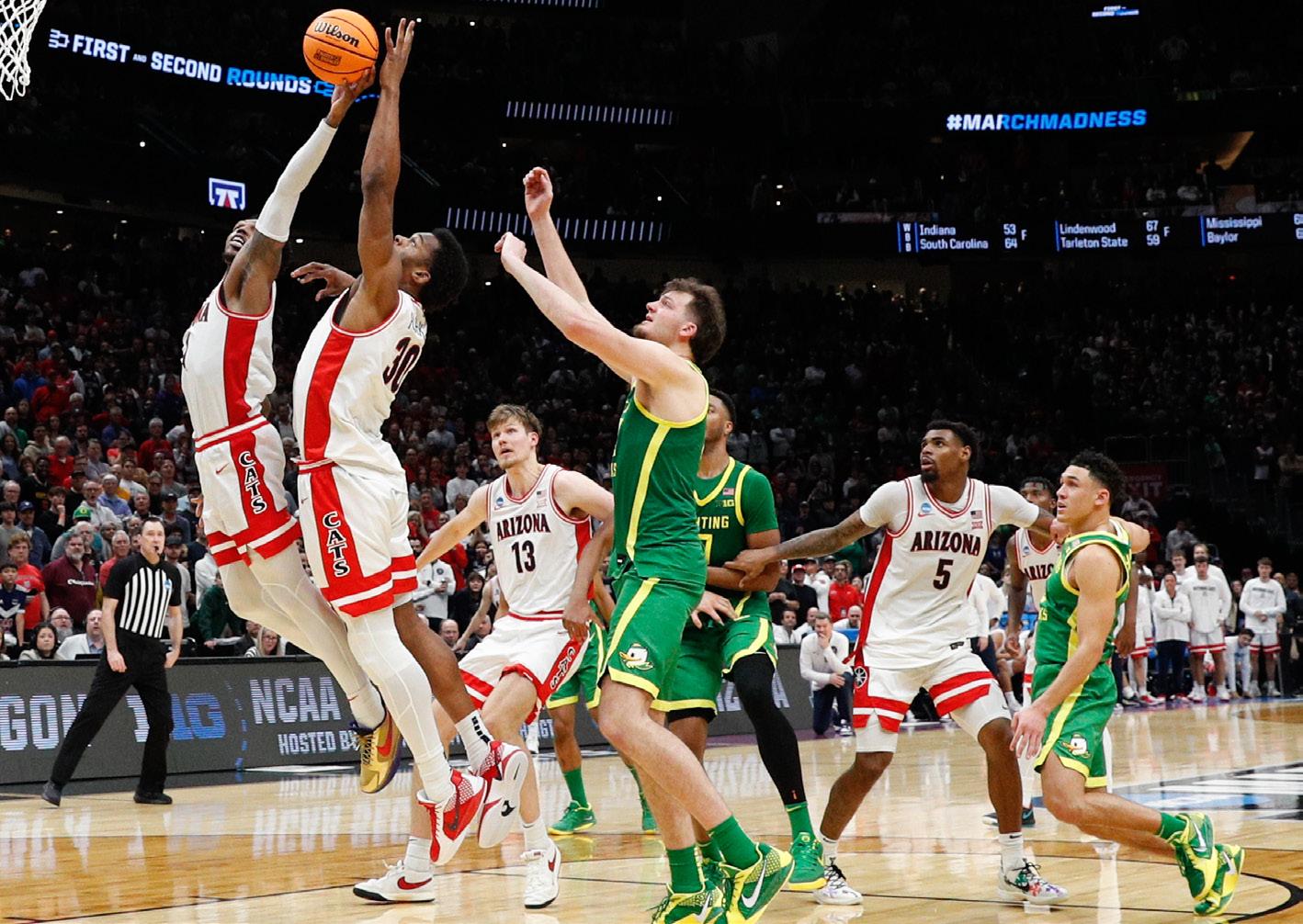
Arizona met No. 3 Iowa State University, where the Wildcats hosted the Cyclones in McKale Center on Jan. 27. During the final seconds of regulation, Love nailed a beyondhalf-court shot to tie the game at 71 to force overtime. The 6-foot-4 guard proceeded to make two more 3-pointers in the extra period, recording 22 points for the night in the unforgettable win.
The month of February began with the Wildcats traveling to face rival ASU in Tempe for the first meet between the two programs this season. Love put up 27 points on 5-for-9 shooting from beyond the arc. Bradley also added 14 points himself to help the Wildcats outlast the Sun Devils 81-72.
Arizona secured two back-to-back victories over BYU and Texas Tech on Feb 4 and Feb. 8. Against the Cougars, No. 20 Arizona at the time held onto an 85-74 victory as Love and Bradley combined for 35 points. Notably, Bradley recorded 17 points just in the second half. Arizona then went to avenge its only Big 12 loss of the season, beating Texas Tech 82-73 for its sixth consecutive victory.
Arizona’s win streak was snapped by Kansas State University in Manhattan, Kansas on Feb. 11, 73-70. Kansas State’s Dug McDaniel put up a season-high 24 points to beat the Wildcats for its sixth straight win and fourth against ranked opponents. The Wildcats also dropped their next game, facing the University of Houston in McKale Center on Feb.
15, but succumbed to a 62-58 loss to the Cougars. Despite Arizona coming back 59-58 with a minute remaining, Houston made 3 of its 4 closing free throws to secure its 17th win in 18 games. The Wildcats went into their final six games of the regular season, going 3-3 against their opponents before heading into Big 12 Tournament play. On the road facing Baylor University on Feb. 17, Awaka recorded his seventh double-double of the season with 14 points and 12 rebounds. This victory allowed Arizona to move into second place in the Big 12 Conference.
However, after beating BYU just two weeks before, the Cougars came into McKale Center looking for their fourth straight win and second over ranked opponents. Despite five Wildcats finishing the night in double figures, including 27 points from Love, it wasn’t enough as Arizona fell in a disappointing 96-95 defeat on Feb. 22. Notably, Awaka secured his second consecutive double-double, consisting of 14 points and 10 rebounds. BYU forward Richie Saunders scored 23 points, including two clutch free throws he made with 3.2 seconds left, giving BYU the victory.
The Wildcats remained home to host the University of Utah, where the
CONTINUED
CONTINUED FROM PAGE 16
Craig Smith. This was the Utes’ first game without him, as assistant Josh Eilert was named interim head coach. Arizona bounced back with a blowout 83-66 win on Feb. 26 with help from Love, draining six 3-pointers to aid the team. Three Wildcats had 12 points apiece, including Bradley, Veesaar and Awaka, who helped Arizona handle Utah.
Beginning the month of March, Arizona traveled to Ames, Iowa, to meet the Cyclones after the Wildcats’ overtime victory at home. This time, Arizona played in the Hilton Coliseum. Iowa State prepared to put on a show, as five of their players scored in double figures for the night, including 11 made 3-pointers. Despite a second-half rally from the Wildcats to get within 9 points of the score, it wouldn’t be enough to overcome the deficit Iowa State had built, losing 84-67. Arizona struggled shooting from beyond the arc, only hitting 18.2% of its shots from deep.
ASU and Arizona met for the rivals’ final appearance against each other this season on March 4. Arizona outlasted the Sun Devils 113-100 as three Wildcats put up 20+ points. Veesaar led the team with 22 points and eight rebounds, hitting 8-of-12 of his shots for the night. Love and Lewis had 21 points apiece. Awaka and Bradley also found themselves in double figures for the evening, adding 15 and 12 points to hold off the Sun Devils’ high-scoring night. ASU guard Alston Mason scored 33 points in the game, but ASU could not find an answer to win against Arizona.
The Wildcats had their last regular-season game against the Kansas Jayhawks in Allen Fieldhouse on March 8. The Wildcats did not find a way to overcome a first-half deficit that put them in position to lose 83-76 on the road. Bradley recorded 21 points, 1 point shy of his career-high and Love added on 16 points himself.
Post-season recap
No. 3 Arizona began its postseason awaiting to see who it will take on in the Phillips 66

Big 12 quarterfinals on March 13 in T-Mobile Center in Kansas City, Missouri. The Wildcats faced No. 6 Kansas once again and were able to pull away with an 88-77 victory over the Jayhawks to advance to the semifinals. Arizona limited the Jayhawks to 33.3% shooting from the field in the first half, forcing them to finish with 77 points for the night just after losing the previous Saturday to Kansas. Veesaar and Lewis scored 19 points apiece while Townsend had 16 to propel Arizona towards the next round of the tournament. Veesaar shot 7-for11 from the field while Lewis also contributed four steals. Arizona’s defense held Kansas as Bryant and Lewis collected five rebounds each. Notably, Arizona outscored Kansas in the paint 46-20 in the victory.
In the semifinals of the Big 12 Tournament, Arizona faced a short-handed Texas Tech team dealing with injuries March 14. The Wildcats found a way to hold off the Red Raiders to gain an 86-80 victory and advance to the Big 12 Championship game. Love scored 27 points on 10-of-15 shooting from the field. Lewis put up 15 points and brought down eight rebounds himself as the Wildcats worked as a team to gain the victory. Texas Tech guard Kevin Overton had 20 points while Christian Anderson scored 19, but it wasn’t enough as the Red Raiders played without two of their top-three leading scorers, Chance McMillian and Darrion Williams. Leading scorer JT Toppin played but stepped out to the arena tunnel as he felt sick, but made it through the game with 11 points in 25 minutes.
The Wildcats found themselves preparing for the Big 12 Championship Title game against No. 1 Houston on March 15. Unfortunately, the Wildcats were met with a 72-64 defeat, closing their first Big 12 Tournament run for the first time in program history. Love led Arizona with 19 points and four rebounds while Bradley followed with 14 points. Houston held Arizona to 27.8% shooting from the 3-point line compared to the 50% made against Texas Tech. With the loss to Arizona, Houston gained its 14th consecutive victory and the Big 12 Title.
With less than a week between the Big 12 Tournament and NCAA play, Arizona waited to see where they would place in the bracket during March Madness. The Wildcats met No. 13 University of Akron on March 21, dismissing the team with a 93-65 first-round victory. Five Wildcats scored in double-figures, led by Bradley, who scored 19 points, including 3-for-5 from beyond the arc. Bryant secured 12 points while collecting five rebounds and three blocks. Despite 12 first-half turnovers, Arizona shot 56.5% from the field and held the
Zips to just 33.3% from the floor to stun Akron as the Wildcats moved onto the second round.
Arizona faced the No. 5 University of Oregon on March 23, where the Wildcats held onto a 87-83 score to beat the Ducks in the final seconds of the game, reaching their third Sweet 16 appearance under head coach Tommy Lloyd. Love had his third-highest-scoring game of the season with 29 points and nine rebounds, including shooting 5-for-7 from the 3-point line. Four Wildcats scored 12 points apiece, including Dell’Orso, Bradley, Awaka and Lewis. Awaka had 14 rebounds, making it difficult for Oregon to gain possessions. The Wildcats shot a collective 45.5% from the field and 50% from beyond the arc. They also outscored Oregon’s bench 20-12 to move on to the Sweet 16 to face No. 1 Duke University.
On March 27 in Newark, New Jersey, Arizona faced Duke, whom Love once defeated in the Final Four in the final game of coach Mike Krzyzewski’s career. This time, the Blue Devils had players on ESPN’s Top 11 NBA Draft Prospects, like No. 1 projected pick Cooper Flagg, who put up 30 points in the 100-93 victory over Arizona. In Love’s final game playing in a Wildcat jersey, the fifth-year guard scored a season-high 35 points on 11-for-21 shooting from the field, including five made 3-pointers. Bradley had 15 points and Veesaar recorded 13, but it wasn’t enough to push Arizona into the next round. The Blue Devils played unselfish basketball as Kon Knueppel put up 20 points, leading second for his team, while Sion James (16 points) and Khaman Maluach (13 points) also aided Duke in the win.
Looking ahead:
As Arizona closes the season and its first chapter in the Big 12, the Wildcats have many moments to be proud of and learn from as they continue to adhere to a new conference. The team has left Wildcat fans with unforgettable memories as Love hangs his Arizona jersey to get ready for a new journey as a player. The Wildcats proved to work through adversity in multiple situations, overcoming ranked programs and allowing new additions to the team to adjust accordingly. With some departures of players stepping away from the program as well as news prospects added, Arizona looks towards a new season to work towards a bigger goal as a team.
The University of Arizona men’s basketball team has seen Caleb Love become the centerpiece of Tommy Lloyd’s Wildcat squad, becoming a quintessential playmaker and leader who will look to one day have his jersey hung from the rafters. Love’s illustrious college career has seen him from his first 3 years as a Tar Heel at the University of North Carolina to becoming the embodiment of Wildcat basketball in Tucson.
Love’s roots come from his upbringing in St. Louis, Missouri, where Love would catch the eyes of colleges nationwide. As a senior at Christian Brothers College High School in 2019–2020, Love averaged 26.3 points, 6.5 rebounds and 3.1 assists. His high school success found him rating as a top-20 recruit across Rivals, 24/7 Sports and ESPN. He closed his high school career as one of the most decorated high school athletes in Missouri. Love went on to win the 2020 Mr. Show-Me Basketball and Missouri’s Gatorade Player of the Year while also being named a McDonald’s All-American.
Love’s success culminated with his commitment to the UNC Tar Heels. He selected UNC after narrowing down his selection pool to the University of Missouri, the University of Kansas, the University of Louisville, Indiana University and, ironically, Arizona. Before Love even touched a collegiate court, he would be touted as a lock as a top-10 pick in the 2021 NBA Draft.
Love’s time as a Tar Heel will forever be remembered by the team’s run in the 2022 NCAA Tournament. Love, Armando Bacot, RJ Davis and Brady Manek would be instrumental in leading the No. 8 Tar Heels to the National Championship game following tremendous success and upsets along
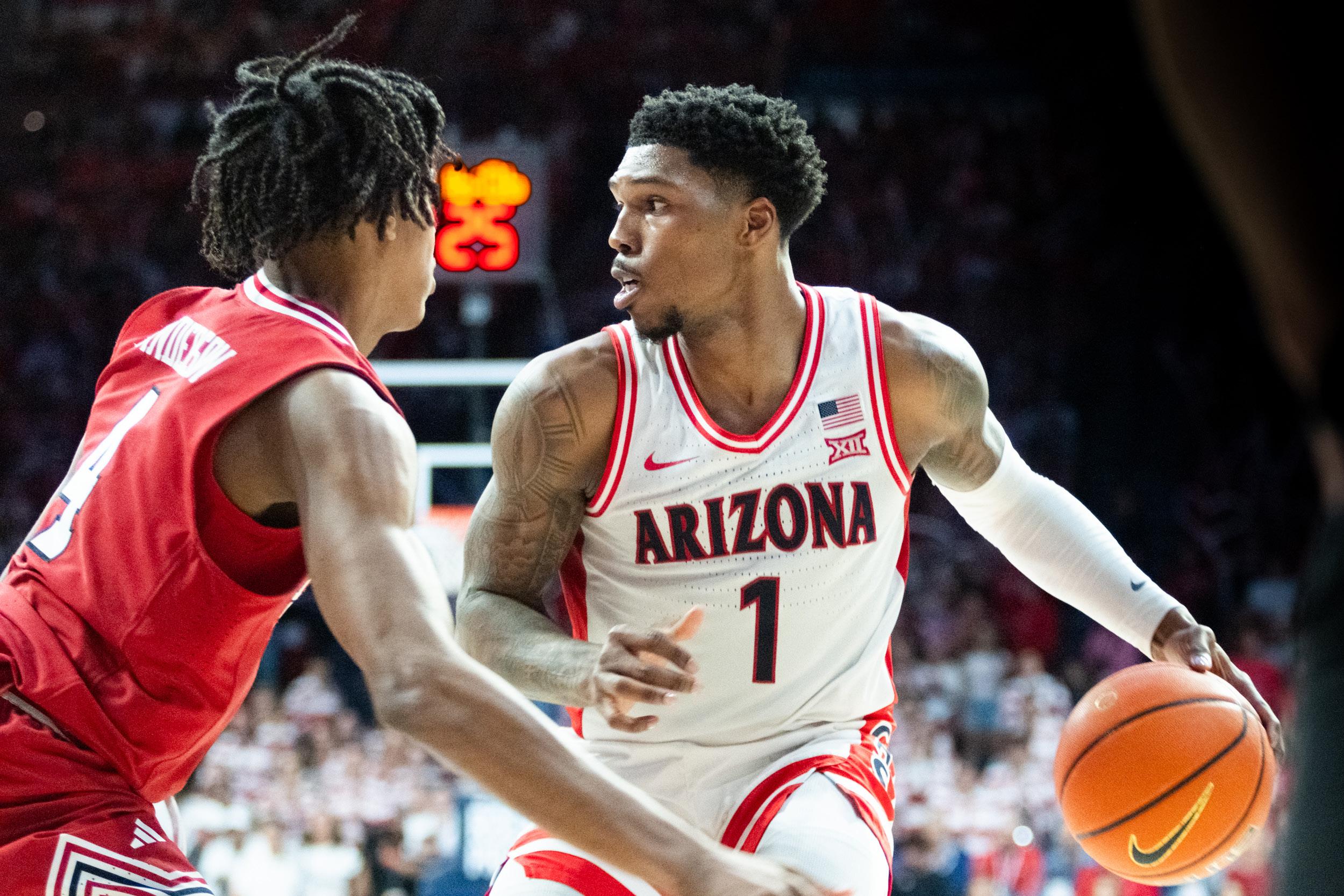
the way, from defeating the then-reigning champions Baylor University, the Cinderella Saint Peter’s University and in-state rivals Duke University.
Against Duke in the Final Four, Love iced the game for the Tar Heels after draining a 3-pointer with 28 seconds remaining. He followed this by sinking three clutch free throws to put UNC over the edge, 81-77. UNC then went on to fall short 72-69 to Kansas in the National Championship as Love struggled, shooting 5-of-24 with 13 points and missing a last-second 3-pointer that would have sent the game to overtime.
The title game appearance was seen to
be short-lived, as UNC missed out on the NCAA Tournament entirely during the 2022–2023 season. In the weeks following, the world saw Love enter his name into the transfer portal, searching for a new opportunity. Although the switch of schools initially looked like Love would transfer to the University of Michigan, transfer credit issues saw the guard switching his commitment to Arizona. Love joined the Wildcats as the team’s mentor and leader, growing from his position at UNC. Love’s impact was immediately felt as the Wildcats opened the 2023–2024 season on an 8-0 winning streak. This included defeating the likes
of Love’s former foes in No. 2 Duke, No. 21 Michigan State University and No. 23 University of Wisconsin. This shot Arizona into No. 1 status, allowing the Wildcats to be put on further national notice.
Despite some tough losses throughout the year, Arizona finished out the regular season ranked No. 5 in the nation. The Wildcats’ record of 15-5 in conference play would be enough to secure them the regular season title. This was the Wildcats’ second regular-season conference title in
CONTINUED ON PAGE 19
three seasons.
This stellar season by the senior guard allowed Love to be named Pac-12 Player and Newcomer of the year, as well as making the All Pac-12 First team. Love was no stranger to conference battles, averaging 20 points, 4.7 rebounds and 3.3 assists throughout the team’s 20 Pac-12 matchups. Arguably, Love’s best conference performance came against the University of Oregon on Jan. 27, 2024. Love recorded a season-high and Arizona career-high of 36 points on 12-for-18 shooting from the field and 5-for-8 shooting beyond the arc.
The postseason proved to be a tumultuous one, with Love initially struggling in Pac-12 tournament play. In the Wildcats’ two games in the tournament, Love averaged 8.5 points on 26% shooting from the field. Despite Arizona getting knocked out in the semifinal, eyes shifted to focus on the upcoming NCAA Tournament. March Madness wouldn’t bring Arizona too much success, as the Wildcats entered the tournament as a
No. 2 seed, eventually succumbing to No. 6 Clemson University in the Sweet 16.
Love’s first season as a Wildcat may not have finished how it was intended, but he continued to prove his role as Arizona’s leader day in and day out. Arizona’s identity almost became synonymous with Love, as he led the show. Love then entered his name into NBA Draft consideration; however, he would later pull this consideration to run it back with the Wildcats for his fifth year of collegiate basketball.
Love’s impact was felt immediately, and his experience shined as he brought an Arizona team to the Sweet 16 that had previously fallen out in the Round of 64 to No. 15 Princeton University the year prior. The accolades he received speak for him as well. His impact on the court in a new conference and leading the team to success was a tremendous start and one he wanted to prove yet again as the Wildcats entered the Big 12.
Love’s second year as a Wildcat and fifth in his collegiate career did not see immediate success as the Wildcats slipped 2-1 by the end of the Battle 4 Atlantis Tournament.
The fifth-year guard would be instrumental in Arizona’s late season resurgence, as the Wildcats dominated conference play, tying for first with the University of Houston for most of the regular season, finishing the season with a 14-6 conference record placing fourth overall.
Love finished the season with seven 20+ point games, having his best statistical outing against TCU in the conference opener that saw Love drop 33 points, seven assists and seven rebounds. However, Love’s most memorable outing came against then-No. 3 Iowa State University, where he shot a beyond half-court heave to send the game to overtime, which the Wildcats ended up winning after Love put up two more 3-pointers in the extra period to secure the victory.
Arizona’s late season comeback didn’t stop in the regular season, as the Wildcats made a push in the Big 12 tournament. Arizona defeated the likes of the University of Kansas and Texas Tech University to reach the Big 12 Conference Championship. Love would be crucial in the upset over Texas Tech he dropped 27 points on

5-for-8 shooting from beyond the arc. The Wildcats would fall just short in the conference championship to Houston in a 72-64 loss. Despite falling short, Love posted 19 points and four rebounds. Love and the Wildcats rode their momentum into the NCAA Tournament. Arizona first flew by the University of Akron in a 93-65 beat down. Love’s pedigree shined quickly, as despite some shooting struggles, he was able to facilitate Arizona’s offense with seven rebounds and four assists. Arizona’s Round of 32 outing against former Pac-12 foe Oregon would not just show Love’s offensive facilitation, but also his scoring prowess as he put up 29 points on 5-for-7 shooting from the arc with a season-high nine rebounds and four assists. Arizona’s 87-83 victory over the Ducks would pit them against Love’s longtime rivals of Duke in the Sweet 16.
Love’s final collegiate game and final game as an Arizona Wildcat wasn’t without Love’s all. In Love’s ninth game against the Blue Devils, he gave everything for Arizona, putting up a seasonhigh 35 points on 11-for-21 shooting from the field with four rebounds and one assist. Despite being overcome by Cooper Flagg and company, Love’s storied college career came to an end in an all-time performance.
Love systematically changed the way Arizona played and helped usher in a new era in Wildcat basketball under Tommy Lloyd. Love defined himself as the program’s leader and did nothing short of pushing the program to its best. While some may look back and say he fell short of getting Arizona a national championship, Love has left an indelible mark on Arizona, one that will take years to fill. Love’s prowess and experience allowed this team to adapt and take charge. Love’s leadership and commitment to team success looks to be passed to other key Arizona players and future Wildcats.
With Arizona having one of the best recruiting classes as of late with fivestars Koa Peat and Brayden Burries, Arizona’s future seems bright. Whoever is the next leader for the Wildcats will need to be one to fill the shoes that Love has left behind.
BY MICHAEL SMITH
The University Arizona women’s basketball team closed its first season in the Big 12 with a 19-14 overall record of and a 10-8 conference record. Adia Barnes finished her ninth year at the helm, leading the Wildcats to the first round of the Women’s Basketball Invitational Tournament, where Arizona fell to NAU 71-69 on Thursday, March 20.
The Wildcats had eight players returning this year, along with five new additions coming from the transfer portal, high school and international. The returning players included fifth-year forward Isis Beh, junior and dual sportathlete Erin Tack, sophomores Jada Williams, Skylar Jones, Breya Cunningham and Brooklyn Rhodes and redshirt sophomore Montaya Dew. Barnes found talent internationally, recruiting freshman German guard Mailien Rolf and first-year forward Katarina Kneževic from Belgrade,
Serbia. Through the transfer portal, the Wildcats picked up three players, led by junior guard Paulina Paris from the University of North Carolina, sophomore Sahnya Jah from the University of South Carolina, the 2023-2024 NCAA Champions, and former Pepperdine University forward Jorynn Ross. Barnes closed out the roster by signing fourstar high school prospect Lauryn Swann from New York.
Regular season recap
Arizona opened the year 5-0 before suffering its first loss on the road against NAU on Wednesday, Nov. 20, falling

92-75 with Williams out due to injury. In the next seven games before conference play, the Wildcats went 4-3, including losing back-to-back games in the Acrisure Series in Palm Springs, California, falling to Vanderbilt University 71-60 and the University of California, Berkeley 74-62. Arizona then returned home and went 3-1 in that span, losing a heartbreaker to GCU 69-66 on Thursday, Dec. 5, but responded by winning back-to-back games against Cal State Bakersfield 76-39 and Weber State University 87-66.
The Wildcats carried the momentum and opened up conference play with a win in Provo, Utah, defeating BYU 57-53, extending their win streak to three games in a row. However, over the span of the next five games, Arizona struggled, going 1-4. The most notable victory was in dominant fashion over the University of Central Florida, 75-53, with Jones coming off the bench, scoring a game-high 17 points and going 5-for-5 from the floor. Notably, Williams finished with 15 points, four assists, shooting 50% from beyond the arc and achieved 500 career points in the win.
Finally, Arizona was 11-8 and 2-4 in Big 12 play after facing its first ranked opponent of the season in No. 11 Kansas State University and losing 62-47 on Thursday, Jan. 16, pushing Arizona’s losing streak to three consecutive games.
The Wildcats bounced back and picked up three huge wins over the University of Kansas, 74-59 on Jan. 19, University of Cincinnati, 72-62 on Jan. 22 and upset No. 16 West Virginia University 77-62. During this stretch, Cunningham accomplished multiple
CONTINUED ON PAGE 21
CONTINUED FROM PAGE 20
career milestones, achieving a career high in rebounds, bringing in 15 in the win over Cincinnati. Cunningham would also complete 500 career points and 100 career blocks in the upset win over West Virginia. Paris joined Cunningham in the career accomplishments by securing 500 career points against the Mountaineers and 100 career assists against Cincinnati.
Throughout the three-game win streak, Arizona averaged 74 points per game, shooting 50% from the field with more than four players scoring in double figures, all while picking up the team’s first ranked win of the season.
Arizona’s victory over the Mountaineers would be the last game Jah played in the regular season after the sophomore transfer was suspended 10 games from the NCAA. Barnes did not comment on the reasoning behind the suspension.
After collecting three consecutive wins, Arizona only won one of its next five games, going winless on the road against University of Utah and University of Colorado, Boulder and losing to No. 20 Oklahoma State University and No. 11 TCU. Despite losing to the Horned Frogs, Jones scored a career-high 30 points on 9-for-11 shooting and went 4-for-4 from deep.
Arizona’s only win during the fivegame stretch was against rival ASU, 66-59, on Saturday, Feb. 8. Williams led with 18 points and seven rebounds, with Cunningham following with 16 points and eight boards of her own. Beh finished with 8 points and five assists and surpassed 500 career points in the win.
Nearing the end of the regular season, Arizona was on the bubble for the NCAA Tournament and needed to win out in order to make a case to receive a bid for the fifth consecutive year.
Arizona capped off the regular season on a four-game win streak. The Wildcats swept the season series against BYU and ASU, defeated the University of Houston 74-72 in over-
time and recorded a victory on Senior Night against Texas Tech University. In the overtime win over the Cougars, the Wildcats saw four out of five starters finish the night in double digits. Cunningham, who finished with her fifth career double-double, put up 17 points for Arizona and tied her career-high with 15 rebounds. Williams and Beh secured 18 points apiece while Jones followed with 16 points, going a perfect 8-for-8 from the charity stripe. She also added on five steals, all while accomplishing 500 career points.
In the 66-57 Senior Night win over Texas Tech, Dew finished with 8 points, eight rebounds and three assists on 75% shooting, but exited the game early after suffering a season-ending leg injury. This forced the Wildcats to have limited front-court depth as the team headed into the conference tournament.
Closing out the season, the Wildcats recorded a season-high 15 3-pointers in their crushing 71-59 victory over the Sun Devils. Arizona shot 53.6% from deep with Swann playing a huge role, shooting an impressive 6-for-8 from beyond the arc, finishing with a teamhigh 18 points.
The Wildcats finished the regular season going 4-0 and made the Phillips 66 Big 12 Women’s Basketball Championship as the eighth seed, receiving a first-round bye. The team was focused on making a statement in its first year in the Big 12 tournament and pursuing the NCAA Tournament.
Arizona was second in the conference when it came to collecting steals, taking away 10.3 per game. The team was ranked seventh in 3-point percentage, shooting 0.347. Cunningham placed 26th in the country in field goal percentage, shooting 0.567, and was named All-Big 12 Honor. Swann was named to the All-Big 12 freshman team. Postseason recap
The Wildcats entered the Phillips 66 Big 12 Women’s Basketball Championship as the No. 8 seed and faced off against No. 9 seed Colorado in the second round of the conference tournament on Thursday, March 6.
Jones led all scorers with 17 points on 70% shooting and Beh finished with a career-high 14 rebounds, 9 points and
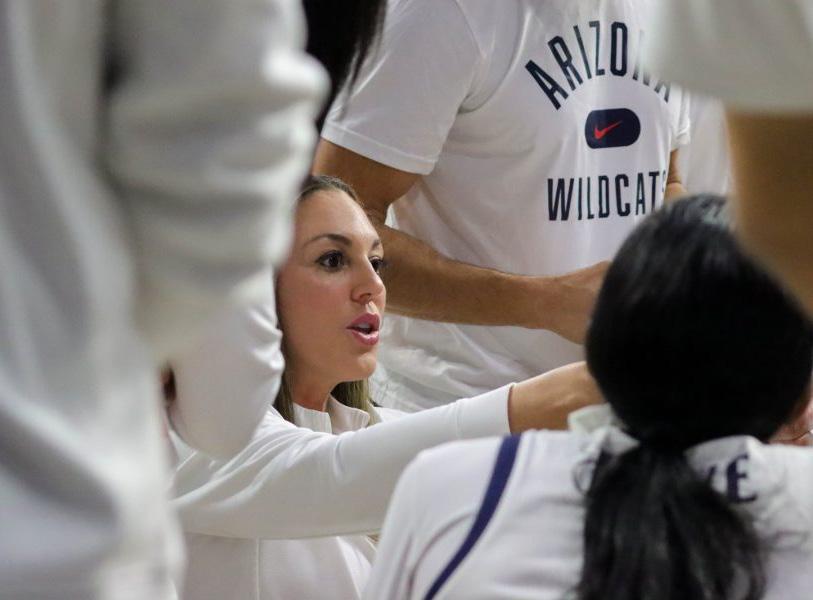
three steals. Despite the Wildcats’ effort, Arizona fell short to the Buffaloes, succumbing to a 61-58 loss, bringing the conference tournament campaign to an early close.
A week later, the Wildcats were selected as the No. 2 seed in the Women’s Basketball Invitational Tournament.
Arizona was set to host NAU in the first round on Thursday, March 20, seeking revenge from the 17-point loss in November.
Three of Arizona’s starters scored in double figures, led by Jones, who dropped 21 points and nine rebounds. This was followed by a double-double from Cunningham, who finished with 19 points, 11 rebounds and a game-high five blocks. Swann rose to the occasion, scoring 13 points and bringing in five boards, going 4-for-4 from the line with Williams not being available to play.
Even with the valiant effort, NAU’s Sophie Glancey and Taylor Feldman were too much for the Wildcats to come up with a response, as the Lumberjacks came away victorious 71-69. Glancey led all scorers with a double-double consisting of 23 points and 14 rebounds. Feldman dropped 22 points while dish-
ing out five assists herself, putting an abrupt end to Arizona’s season. Looking ahead
As the 2024-2025 season for Arizona wraps up, the Wildcats reflect on a journey full of a wide range of emotions. The program overcame many obstacles throughout its first season in the Big 12. Nonetheless, players like Beh and graduate senior Ajae Yoakum have this season to cherish for a lifetime.
After the team’s post season games, Barnes announced she was joining Southern Methodist University as its next head coach, ending her Arizona contract a year early. Barnes spent nine seasons guiding the Wildcats. Becky Burke was announced as the 10th head coach in program history as she enters the 2025-2026 season. Williams headlines the group that will not return to the team, recently announcing her commitment to Iowa State University. The other nine players who have announced their names into the portal include Jones, Cunningham, Jah, Kneževic, Ross, Paris, Rolf, Swann and Yoakum.
OSCR TECH ZONES
Noah Tariq Abdellatif
BSBA in Management Information System
Victor Adegboye Adeyemo
BA in Economics
Dylan Ray Blair
BA in Management Information Systems
Leo Ivan Brown
BS in Mathematics; BA in Economics
Carlos Castellanos-Mendoza
BS in Information Science
Malcolm Ulysses Hayes
MS in Electrical & Computer Engineering
Nathan J. Mette
BS in Computer Science
Sebastian Pimentel
BA in Biochemistry; BS Physiology and Medical Sciences
Manny Isaiah Ries
BS in Management Information Systems
Melanie Galvan Salazar
BS in Biochemistry and Molecular & Cellular Biology
Leah Gebremariam Tesfaye
BA in Computer Science
24/7 SUPPORT CENTER
Hunter Del Rosario
BSBA in Management Information Systems
Diego Garcia- Jimenez
BSBA in Finance
Dalian Meraz
BS in Electrical & Computer Engineering
Kobe Voss
BSBA in Management Information Systems
UITS DESKTOP SUPPORT
Marco Manzo
BS in Systems Engineering
KNOWLEDGE TEAM
Aaron Bustamante Reyes
MS in Management Information Systems
ISO SECURITY OPERATIONS CENTER
Antonio Cruze
BAS in Cyber Operations – Defense & Forensics
Samuel Knox
BAS in Cyber Operations – Defense & Forensics
Amber Krock
BAS in Cyber Operations – Defense & Forensics
Rachel Whitaker
BS in Computer Science
UNIVERSITY OF ARIZONA APP
Claire Lodermeier
BA in Computer Science
Sasha McDonald
BFA in Illustration, Design, Animation
Margo Mykhaylyk
BS in Video Game Design & Development
Nataly Sotelo
MS in Marketing
Kelly Tran
BA in Information Science & eSociety
TRELLIS
John Martin Encinas
BS in Software Engineering
Elodie Hilbert
BS in Computer Science
Kyle McIllece
BS in Mechanical Engineering
RII BIO5 IT
Kendall Beaver
MS in Information Science - Machine Learning
Nicholas Kaplan
BS in Information Science; BA in Information Science and Arts
Sherali Ozodov
BS in Information Science
RII CORE FACILITIES IT
Khamdam Kadirov
BA in Computer Science; BS in Information Science
CONGRATULATIONS, Eddy Olguin, student worker in College of Law IT Support from the San Miguel High School Work Study Program, graduating in May!
BUSINESS AFFAIRS TECHNOLOGY
SERVICES
Carlson Factory
MBA in Business Administration; Certificate in Entrepreneurship
HOUSING & RESIDENTIAL LIFE SERVICES
Jose Luis Fragoso
Master in Organizational Leadership (NAU)
COMMUNICATIONS & MARKETING
Kelly South
MBA in Marketing and Privacy & Security
Alana Talkington
MA in Global Media
OPERATIONS & ADMINISTRATION
Emily Geiges
BBA in Management (NAU)

BY KANISHKA CHINNARAJ
The Daily Wildcat
The recently passed House of Repreentatives budget reconciliation bill aims to cut Medicaid spending by up to $880 billion or more over a decade. What is Medicaid?
Founded in 1965, Medicaid is the primary program providing comprehensive health insurance coverage to 79 million low income people across the 50 states as of 2024.
Traditional Medicaid coverage is limited to “low-income children, pregnant women, parents of dependent children, elderly individuals, and individuals with disabilities” with an income up to 133% of the federal poverty level.
With the implementation of Medicaid expansion under the Affordable Care Act, Medicaid now covers adults under the age of 65 with incomes up to 138% of the federal poverty level regardless of whether they fit into the traditional eligibility requirements.
Medicaid expansion significantly reduced uninsured rates as it opened doors for many that fell under the coverage gap and has been adopted by all but 10 states. Expansion has increased access to healthcare services covered by insurance such as preventitive services, mental health and substance use treatment and prescription drugs. How does Medicaid funding work?
Currently, Medicaid is jointly financed by states and the federal government following the Federal Medical Assistance Percentage. FMAP is designed to guarantee at least 50% match rate in all states and provides a higher match rate for states with a lower average per capita income.
Essentially, the federal government is required to pay a minimum of $1 for each $1 the state government pays towards Medicaid.
For this year’s federal fiscal year, Arizona receives an FMAP rate of 64.34%; for every $1 the Arizona state government pays, the federal government pays $1.80.
The second FMAP rate is for expansion states, who can receive match rates as high as 90% funding from the federal
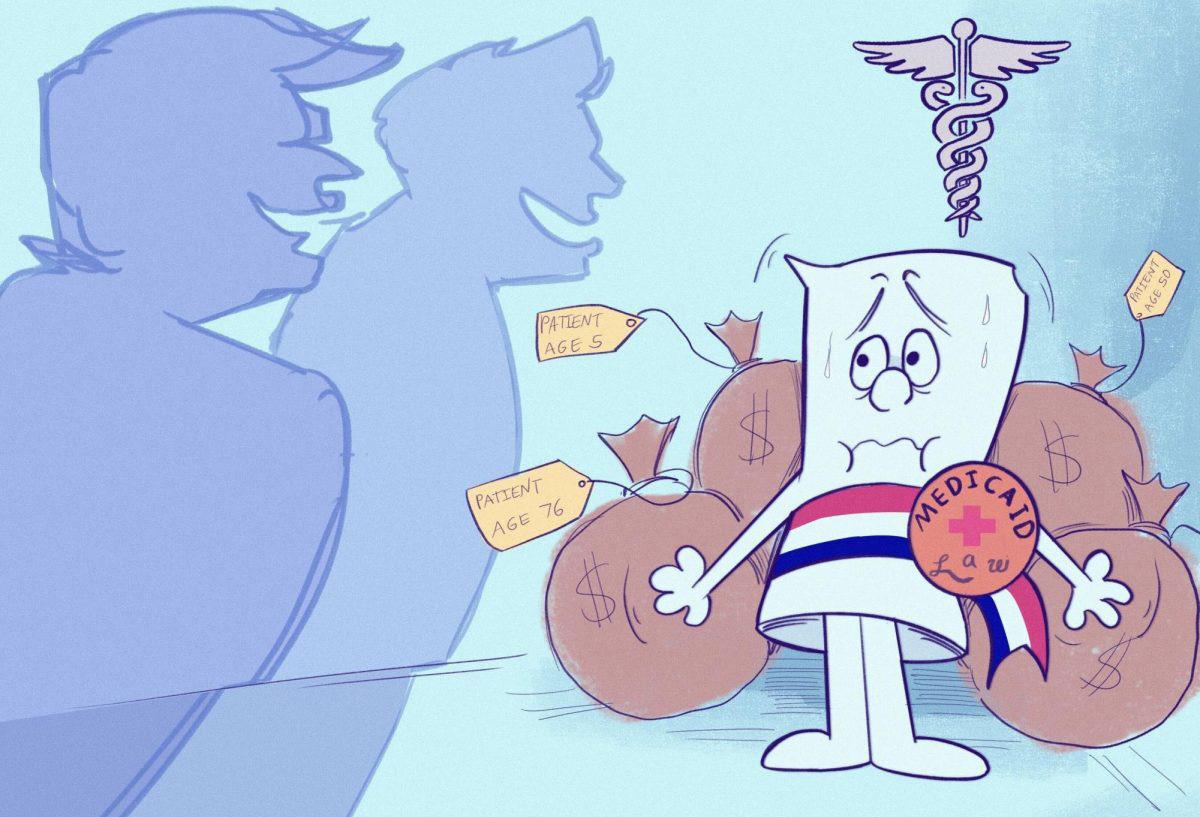
government, meaning the federal government pays 90% of the costs only for individuals covered under the ACA Medicaid expansion.
Trigger law creates uncertainty
Trigger laws are embedded within state legislation to protect states from unwarranted increases in contributions for Medicaid funding.
If federal support were to fall below a predetermined threshold, for Arizona the trigger is set at 80%, this would force the state to automatically end Medicaid expansion.
According to The Center For Community Solutions, not every state trigger law calls for automatic termination of Medicaid
expansion, however in Arizona “a reduction in federal support, even by a small margin, would automatically cut off the federal funding stream that underpins expansion, with no further action required from state lawmakers.”
In simpler terms, If the proposed budget passes and Medicaid funding is slashed, Arizona would be forced to withdraw from expansion services, jeopardizing the health of its most vulnerable populations. What are the main motivators to end the program?
During a town hall meeting on March 21, Senator Mark Kelly addressed concerns regarding potential Medicaid cuts. He noted
the rationale behind these proposed changes; how the administration, specifically President Donald Trump, aims to double down on 2017 tax cuts, a handout to the wealthiest Americans in our country.
Kelly further explained how extending these tax cuts would cause the debt deficit to be about $6 trillion, and in order to offset these costs and achieve savings, the Trump administration aims to cut federal funding for programs like Medicaid or Medicare.
CONTINUED FROM PAGE 23 provided insight to the extent of how many Arizonans will be affected if Medicaid cuts take effect.
Another large motivator is President Donald Trump and Elon Musk’s narrative of waste, abuse and fraud in federal programs.
Elon Musk’s Department of Government Efficiency has been given read only access to the payment and contracting systems at the Centers for Medicare and Medicaid Services.
In a post to X, Musk said “big money fraud is happening.”
Kelly addressed this alleged fraud.
“I think we should always be looking for opportunities to make programs run more efficiently […]. We should look for those opportunities, but they throw around this word fraud all the time ‘that there’s fraud in the Medicaid system’ and you don’t hear them talk specifics because they really can’t find that part of it,” Kelly said. “This is just really slash and burn. And again, remember why they’re doing this. They’re trying to come up with some room, so the tax cut for billionaires does not look so bad.” How will this affect Arizonans?
Daniel Derksen, director of the Center of Rural Health at the University of Arizona and the associate vice president for Rural Health Workforce Development Initiatives,
“I estimate that probably 520,000 Arizonans that are currently covered by Medicaid will lose coverage. That’s substantial. You’re not saving money when you throw people off of coverage. You’re just shifting the cost,” Derksen said.
The costs that would have been covered by Medicaid and marketplace will be now placed on the states to come up with the difference. The catch is that states can’t come up with the difference required to cover people who rely on Medicaid services.
The cost is shifted towards hospitals, nurses and physicians who would have to absorb a higher burden through providing uncompensated care and to individuals who do not have resources to pay out of pocket.
Kelly shared how his granddaughter goes to El Rio, which is a federally qualified health center.
“It’s likely that her pediatrician might not work there anymore if there is a drastic cut to access in our state, or maybe they wind up having to close down a certain clinic and they lose staff. If they lose half of their revenue through Medicaid, let’s just say as an example, it’s going to affect everybody that goes there. And that’s probably true for every health facility and every
hospital in our state,” Kelly said.
Derksen said Medicaid has been the single most stabilizing factor especially in Arizona’s rural areas, and how despite having a record low uninsured rate in Arizona, as a family physician it is still too high.
Right now the state has around 750,000 to 800,000 uninsured, which is around one in 10 Arizonans. If the state were to lose Medicaid funding that would put Arizona to one in five being uninsured, doubling uninsured rates.
Another large component of cuts in funding is the loss of tens of millions towards the ACA Navigator program, from $98 million to $10 million.
Navigators are a crucial part of providing assistance to individuals and families in Arizona enrolling in the marketplace and Medicaid, and according to Derksen, navigators have helped over 400,000 Arizonans sign up for health insurance.
“That’s what navigators do. They help people understand what can be very complicated like what their cost sharing responsibility would be as far as co-pays and deductibles. They are helping people with understanding what they are eligible for. For example, some people don’t realize that they have employer sponsored coverage. So navigators are assisting people realize, oh, you work here, they provide health
insurance. And oh, here’s your income level. Here’s what you and your family are eligible for. Oh, your children are eligible for KidsCare,” Derksen said.
Navigators are ensuring communities in Arizona are aware of their health insurance options and assist in enrolling individuals and families in affordable plans based on their eligibilities for the ACA marketplace, known as AHCCCS in Arizona, but also for Medicaid or KidsCare, known as Children’s Health Insurance Program in Arizona.
These potential cuts would ultimately result in fewer professionals to provide assistance and educate people within Arionza’s communities about their eligibility and enrollment for Medicaid and other marketplace plans.
The ACA subsidies which make the marketplace plans more affordable will also be expiring this year in December, unless renewed by Congress, would also result in a substantial reduction in the number of people being able to afford marketplace plans as the co-pays and deductibles will rise considerably.
“My analysis is that as many as 150,000 Arizonas would lose their marketplace coverage if those subsidies aren’t extended,” Derksen said.

BY EMMA LAPOINTE, JASMINE CREIGHTON
The Daily Wildcat
On March 31, University of Arizona students were left confused and concerned after emails from the International Student Service reminded international students to carry their visa and passport while on campus.
Since the news was sent to UA students, multiple ASU students have had their visas revoked. Similar events have happened at campuses across the country.
The email from ISS stated, “Keep copies of your immigration documents in a readily accessible place. It is recommended that you carry a copy of your passport, I-94 and proof of status at all times.”
The email also told students to check for updates on immigration situations from the Department of State and to look out for potential travel bans that could impact students traveling back to their native countries.
Rumors were spread via social media on April 3 about the presence of U.S. Immigration and Customs Enforcement on campus.
According to UA officials, they have no knowledge of ICE being present on campus, and the claims have not been supported by concrete evidence. Community members are also unclear about where the rumors started and where they came from.
According to university spokesperson Mitch Zak, the university could not confirm or deny whether students have had visas revoked.
“I wanted to point out that the university will not address whether or not students, faculty, or international scholars have had their visas revoked for privacy reasons. I recognize that there have been unconfirmed reports and wanted to provide that clarification,” Zak said.
The Arizona Daily Star reported that the UA administration refused to accept a public information request sent by the newspaper last week.
“The Star is only asking for the university to follow state law in releasing information to the public. No state entity is
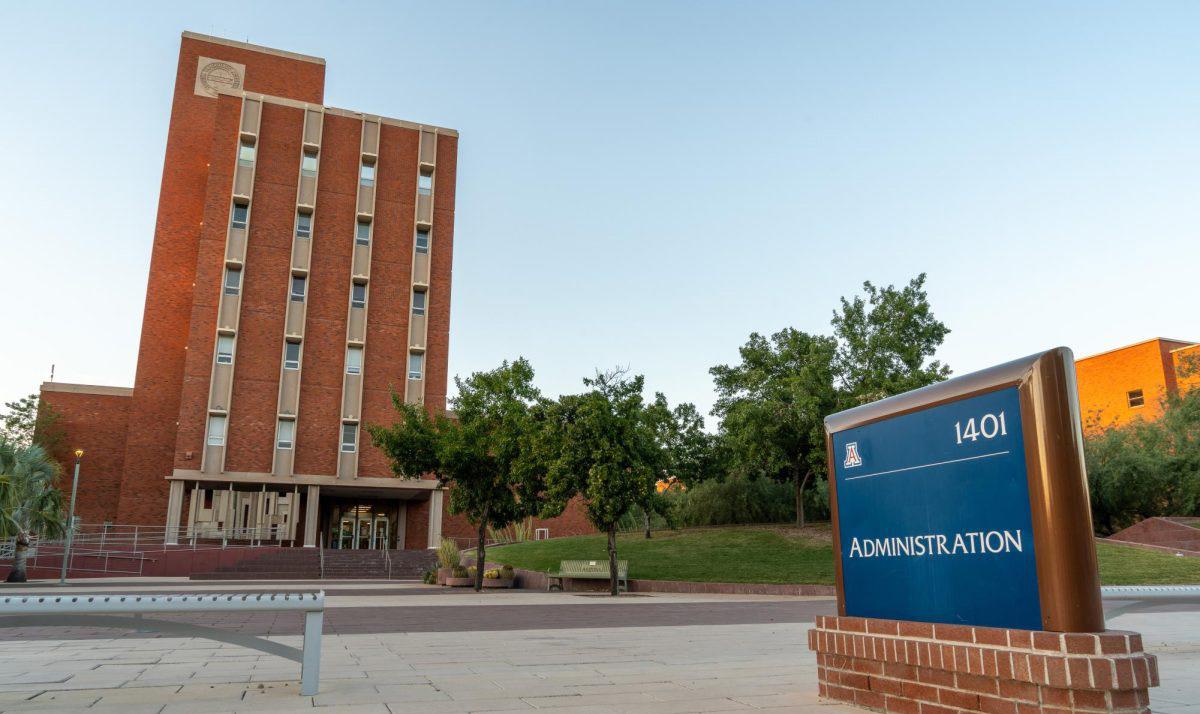
immune from public-records law,” the article said. “If complying with records requests is not within the university’s resources, the administration needs to inform the Regents that it is in violation of the law and needs funding to rectify the situation.”
The Arizona Daily Star also reported the refusal to release the number of students with revoked visas.
“U of A officials weren’t able to answer that question to our satisfaction, saying merely that the university had decided to take a conservative approach to information release,” the article said.
The Arizona Daily Star said that they were able to get the same information from ASU, and does not understand why the UA is unwilling to comply.
According to Chief Safety Officer Steve Patterson, the university is not aware of any federal law enforcement on campus.
“The university is not aware of any federal law enforcement activity involving students, faculty or staff. We care deeply about the safety and wellbeing of our campus community. Anyone with concerns about suspicious or criminal activity should contact the University of Arizona Police Department, while students experiencing stress or facing difficult circumstances are encouraged to reach out to the Dean of Students Office for support,” Patterson wrote.
An update on the Federal Landscape page of the Office of the Provost website was released following the recent concerns in UA policies regarding student visas. It includes information on procedures with non-university law enforcement.
The update explained that a large portion of the university’s campus, like the UA Mall, is open to the public, including to non-university law enforcement. However, law enforcement officers are not permitted entry without cause into other areas, such as classrooms and dormitories.
“In most circumstances, law enforcement officials may not enter a classroom, laboratory, dorm room or private office without a warrant, a judicial order or exigent circumstances,” according to the update.
It is unknown how the school’s policy will coordinate with the Trump administration’s recent rescission of protected areas from ICE. Places such as schools are no longer protected, and ICE officials can enter certain public areas of campus without any warrant. However, non-public areas require permission from a university official.
The update shares that university employees must cooperate with non-university law enforcement and not interfere with their work by blocking entries or doorways. It also instructs employees to redirect law enforcement to UAPD offices or wait for a UAPD
officer to arrive on the scene to address the situation.
Regardless, students feel nervous, concerned and confused about what to do next. UA student Shanshan Zhang said she does not feel safe going on campus following the ISS email and the rumors.
“For me, the university is doing nothing but complying,” Zhang said. “I feel like, I guess [the university is] not going to protect me. I guess I will just do my strategy right now. I will just stay at home.”
After the rumor, Zhang felt more scared to come on campus and contacted her other international student friends to warn them about what was happening.
“I recommended to her [Zhang’s international student friend], ‘Hey, if you go out for anything make sure there are people around you,’” Zhang said. “She started to send me some news of threats from RedNote. Some Chinese students post stuff. They are saying their visas got revoked just because of a traffic ticket two years ago.”
Zhang sees UAPD in the same position as the Tucson Police Department, and feels that neither will protect her nor warn her if ICE does show up on campus. Since the email was sent, Zhang has contacted a lawyer. The lawyer told her not to panic or pack her things but to stay in America.
“They just want to create this fear and scare us,” Zhang said, repeating what her lawyer told her. However, she feels that Zhang must protect herself.
The advice that Zhang was told was that if she went out, she should try to find people who had citizenship and remain calm.
Zhang clarified that remaining calm meant not participating in protests that bring attention to herself, committing crimes or anything that might give police a reason to keep an eye out for her.
For students concerned about ongoing policies and who want to learn more about what to do, the Thrive Center has a page for Immigrant Student Resources.
Patterson also encouraged students to contact the Dean of Students Office for support if they are experiencing stress or difficult circumstances.
BY ARA ARELLANO
The Daily Wildcat
In today’s world, with the rapid advancement of technology, artificial intelligence is clearly the next step in our evolution. Yet many educators and institutions have been quick to criticize and demonize this technology instead of embracing its potential.
The era of ChatGPT in higher education has ushered in significant challenges. Professors are increasingly relying on AI tools such as Turnitin to flag students’ work, often without justifiable cause, leading to unjust academic penalties. It is deeply concerning that an unreliable algorithm can undermine the integrity of a student’s academic journey and alter their life.
When Turnitin was first let loose into the world, it claimed it had less than a 1% false positive rate. However, more studies are coming out showing that the false positive rate is relatively higher and more random than previously reported. In an article by The Washington Post, researchers found the false positive rate was actually 50%. Granted, the sample sizes were different for both studies, but still, shouldn’t educational institutions hold themselves to a higher standard before risking a student’s academic future based on the potential use of AI?
In another article by Vanderbilt University, researchers claimed that “to date, Turnitin gives no detailed information as to how it determines if a piece of writing is AIgenerated or not. The most they have said is that their tool looks for patterns common in AI writing, but they do not explain or define what those patterns are.” Despite the growing evidence of these flaws, educators persist in trusting these unreliable tools, often without considering the devastating consequences for students, all while disrupting environmentS and relationships between students and professors.
I’ll admit that until my third year in college, I had never opened a ChatGPT browser out of fear for my academic standing. But I did, because — let’s be honest — understanding legal cases isn’t simple, so I have AI make the readings into a podcast I can listen to on the bus to school. And writing 10+
page political science papers without an outline and no idea where to start isn’t the easiest thing to do, especially when the education system itself feels like an uphill battle these days.
Despite these tools, professors across campus continue to treat AI as the enemy. For me and many other students, however, it’s an invaluable tool. AI comes in many shapes and forms, including ChatGPT, Grammarly Go, Gemini, Google Notebook LM, Siri, Alexa and even face recognition, to name a few.
AI is literally everywhere, yet people act like it’s a brand-new thing. It’s time to acknowledge that AI is here to stay, and instead of resisting it, we should be finding ways to integrate it into our learning environments responsibly and effectively. But with outdated educators and institutions who continue to vilify AI, students are left to navigate an educational system that refuses to adapt to tools that can actually enhance learning and efficiency.
This semester alone, I have encountered numerous types of professors: one who is open about letting their students use AI for their benefit, one who believes that polished writing is AI writing and one who doesn’t want it on their midterm. But there are also professors on this campus who aren’t afraid of AI like ChatGPT and want to understand it.
Take, for example, Paul Hurh, an associate professor in the English department who has been at the University of Arizona since 2008. Last year, in one of his classes, he designed an assignment that asked students to analyze a text using AI and then to critique the strengths and weaknesses of that AI analysis using their own knowledge of the text.
“My goal with this assignment was not to integrate ChatGPT but to get students to criticize programs like ChatGPT,” Hurh said. This aligns with Hurh’s belief that, as students, we are expected to analyze information and apply critical thinking in both our classrooms and written essays.
“My worry is that programs like ChatGPT will take away the critical thinking aspects and come up with these ideas that students then use to write their papers. But as a professor, those ideas create a barrier,” Hurh said. He emphasized that if the inherent idea is taken away, then is the student really thinking critically?
Unlike other professors, Hurh isn’t quick to

dismiss ChatGPT; he’s opened a number of conversations with his classes about its use, trying to better understand it to adapt his teaching, whether that be to combat AI or use AI. Only time will tell.
“My fear is that it’s the students who don’t believe their writing is good or their grammar is bad or that AI simply does it better, those are going to be the ones who reach for ChatGPT quicker and they are also going to be the ones who miss out because there is a short cut,” Hurh said.
And he’s right. From what will be my 3 years at this institution, education standards of today ask for students to be perfect from the jump, without allowing room for growth, mistakes or the process of learning. The pressure to meet high expectations right away, on the first assignment, no matter how big or small, can be overwhelming, especially when some students, like myself, are also working jobs. Yes, I mean plural. This perfection from the jump mentality ignores the reality that learning is a process focused on progress, and everyone progresses at their own pace.
This standard also stifles students’ creativity and critical thinking; it is in my experience that English classes are the ones where professors focus more on completion for grades rather than
percentage. This is not to say they don’t give feedback or expect better results in the next assignment. They reduce one stressor to give us that freedom to take risks, though, and it’s honestly why those are my favorite classes.
Some of my other classes have prioritized producing a perfect final product over appreciating the process of academic growth and the exploration of new concepts. In this environment, it is hard not to feel discouraged from taking risks or trying new approaches because the fear of failure is so strong. And for someone like me who needs those A grades to get and keep scholarships, how can I not ask AI for help?
AI is not the enemy of learning; it’s a tool that can help students combat the pressures of modern education. AI can help alleviate some of that pressure by providing students with a supportive resource to refine their work, explore new ideas and develop their skills. Rather than viewing AI as a shortcut, educators should recognize it as a valuable tool to help students engage more deeply with the learning process. And until that changes, students will be left to fend for themselves in an environment that often prioritizes results over the learning journey.
BY IAN STASH
The Daily Wildcat
Anyone who has been to the University of Arizona campus and turned their head west knows that the university is neighbored by a towering community of high-rise apartments which many students call home. Built along Speedway Boulevard, their shiny veneer and trendy names that you might expect from some new Silicon Valley startup charm people from great distances. Their websites include flashy designs and pictures of happy people enjoying the various amenities that modern-style living has to offer. They also put emphasis on their proximity to many of the university’s key locations, like the UA Main Library, the UA Mall and Arizona stadium. On the surface, these apartments have the air about them that makes them a fine place for students to spend their college days. It feels like there are more and more all the time, with new construction projects taking root right next to the currently standing ones.
All this comes with a hefty price tag, however. The websites for ōLiv Tucson and Hub on Campus list their price range as between $1,400 and $2,300 per month, just for a starting rate. The Parker Tucson includes similar prices for their floor plans. Aspire Tucson has cleverly listed their cheapest studio apartment, meaning that it is only made up of a single room plus a bathroom, at “from $1,995,” which looks much less alarming to the eye than it would if you added just $5 to that number.
With such a large variety of names on the towers, someone who is looking for a place to live that is close to campus might expect these names to compete with one another by offering lower prices, yet that doesn’t seem to be the case. Why does this competition not seem to not have an impact on price? It’s because there isn’t as much competition as you would expect when it comes to these high-rises. If you

browse the websites of these places and scroll past the fancy graphics, you’ll see a recurring logo at the very bottom.
Many of the high-rises that you see on campus, including the aforementioned oLiv Tucson, Hub on Campus and The Parker Tucson, are not each owned by separate entities competing with one another to be the top choice for students, but are actually just a few of the student housing complexes managed by Core Spaces, a company that builds, owns and operates built-to-rent spaces across the country, with a particular interest in providing housing for college students.
Core Spaces owns six complexes in Tucson, which is more than they own in any other city in the country, in addition to four additional properties in the state of Arizona. They also have their management logo slapped on the websites of complexes they do not own, such as The Parker Tucson. This is the same story that we see all across the country as we remain faced with a widespread housing crisis that many Americans struggle to make ends meet in.
When a single company has so much control over the properties nearest to the UA because there is no competition, it
becomes difficult for students to find cheap and convenient housing while they manage the high costs of living and tuition. This is a challenge in itself when you have to juggle the responsibilities of education as well. With this in mind, lots of students have to look for other apartment complexes that have lower rent but are farther away from campus, meaning that these students will have to reach their classes by foot, bus, bike, car or whatever means are available to them. This need for transportation poses an obstacle and an inconvenience to people that living in the high-rises does not include.
However, there is still another option available to college students who are seeking a place to live that is close to what campus has to offer, but is more affordable than the high-rises: dorms. The UA provides 23 dorms for students, with the rent for the full academic year ranging from $7,090 to $10,320 for a double-occupancy room, all fees included. Compared to the monthly rates for the high-rises that hide their utilities and fees, this university-provided option allows for more affordability while also being accessible to campus. Dorms also, by design, can’t lock a resident into any sort of lease that
ties them into paying rent during summer months when they might not even be in town.
I’m a former resident of the Manzanita-Mohave Residence Hall on the northwest part of campus, and I can attest that it isn’t luxurious living, but it allowed myself and many others before and since to live within walking distance of the university’s classrooms and everything else that campus has to offer while also providing housing that wasn’t as expensive as many of the alternatives. The worst part about living there was the fact that I was repeatedly woken up at 5:30 a.m. by the sound of construction work for the highrise apartments just across the street. However, the number of dorm rooms is limited. For students who don’t apply for a dorm space early enough or transfer part way through the academic year, living in a dorm just might not be an option. This is not made any easier by the fact that the UA seems to have no interest in any new student housing options. Since the Honors Village opened in 2019, there has been no expansion in university-offered housing, and the Honors Village is only accessible to honors students and more expensive than most dorm options.
College campuses are designed to be easily accessible for students, and the right to reasonably-priced housing that students can travel to and from with a short walk should not be limited to those with the ability to pay for a pricey apartment. If more dorms with a reasonable rent were available, then more students could have the same opportunity and accessibility to their university that those in the existing dorms and the high-rises do. Instead of allowing the market to become more and more cornered by companies like Core Spaces, universities like ours should seek to expand their own housing options so that students can choose closer and more affordable places and be saved from the metallic modern building style in favor of our university’s trademark red-brick look.

BY KATE EID
As flowers begin to bloom for spring, Earth Month makes its annual appearance — just in time to remind us that our generous planet needs us just as much as we need it.
It’s easy to get caught up in all aspects of college life, but keeping the Earth clean should never lose its place in our daily lives. We can start creating a greener world just by considering some healthier choices like these: Eat locally sourced food
It’s closer, it’s tastier and it’s cheaper. Engaging with your local farmers markets and neighborhood cafés is a fantastic way to connect with your community and support sustainable living.
According to University of Arizona Nutritional Sciences professor emerita Nobuko Hongu and colleagues in a 2017 article titled “Local Foods in Arizona,” there are innumerable benefits to eating locally sourced food — for both the consumer and the environment.
“Local foods often do not require special packaging for traveling great distances. Thus, buying locally can reduce the use of plastic bags and petroleum based packaging which helps reduce the waste associated with packaging. Fuels, packaging, and preservatives may be applied to maintain freshness of fresh produce. Each has a negative impact on the environment,” Hongu said in the article.
Tucson has some of the most unique local food choices; you’ll be glad to replace your weekly Target runs with them. Just west of campus is Time Market, a quaint restaurant and grocery store that prides itself on serving local produce and sustainable meats.
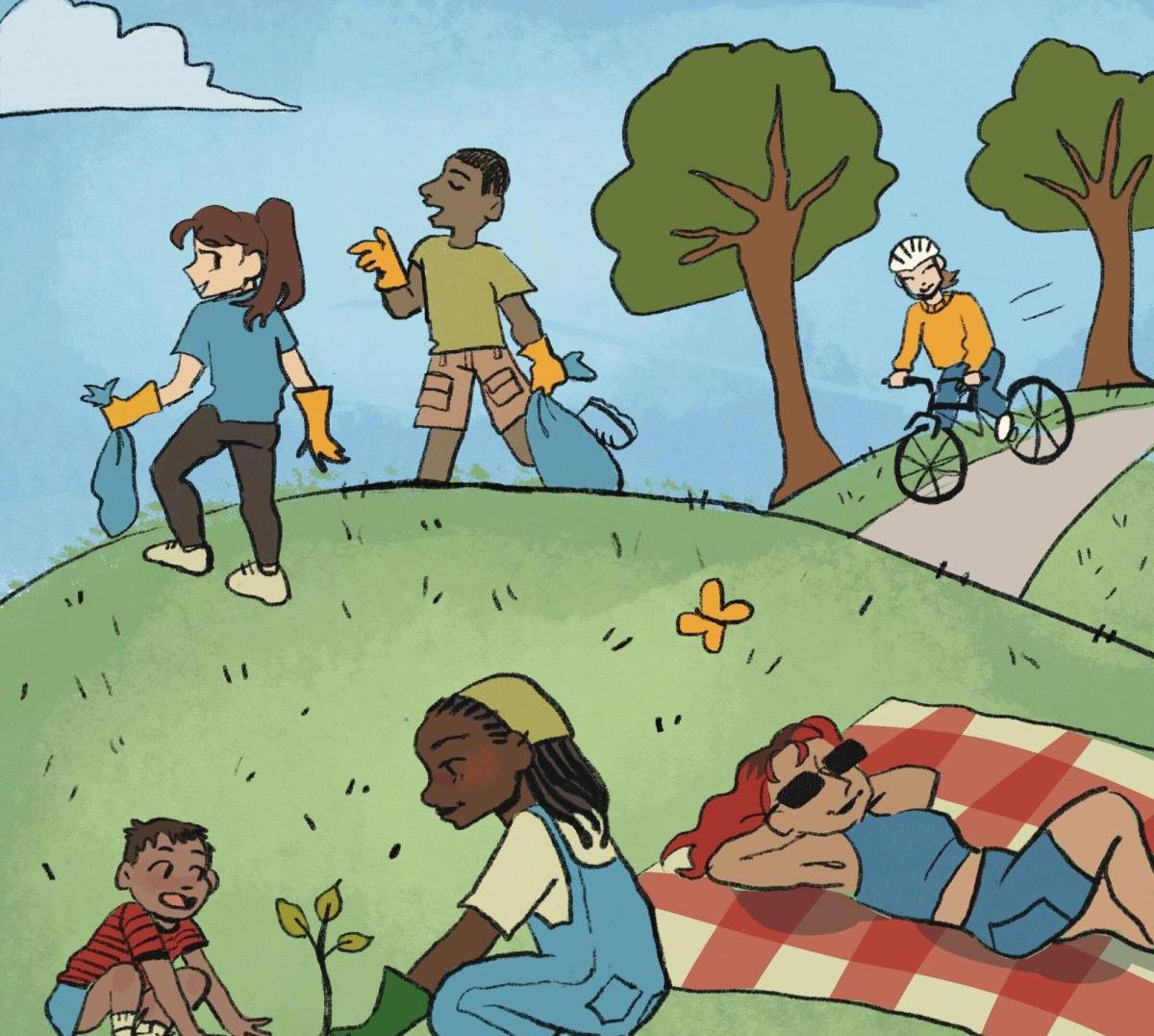
WITH EVERYTHING GOING ON in day-to-day college life, being mindful of our effect on the
small habits we can adopt this Earth Month, and year round, to live more sustainably.
For the more DIY foodies, the community-owned Food Conspiracy Co-Op on Historic Fourth Avenue sells organic,
is not
locally grown foods, along with a full bulk and wellness section.
CONTINUED FROM PAGE 29
You can still eat locally sourced food even if you don’t want to leave campus.
Market on the Move is a project that University of Arizona Students for Sustainability bring to campus on the final Wednesday of every month. From 9 a.m. to 1 p.m. on the UA Mall, this group of students partners with a food bank to hand out free produce, giving back to the community and reducing food waste.
Utilize the divided trash bins on campus
It can be really tough to start a compost of your own or convince your apartment building to provide a recycling option. But the University of Arizona offers resources, like separated bins for paper, plastic and even compost, to reduce the stress of making sure our waste goes in the right place.
The University of Arizona’s Sustainability and Climate Action Plan includes goals aimed at revolutionizing the future of composting and waste management on campus.
According to the Climate Action Plan, “Current composting infrastructure and operations should be expanded so that the University can increase waste diversion to compost by 50% in 5 years, and divert 90% of compostable waste by 2040.”
While this goal sounds incredibly
refreshing in an era of environmentally inconsiderate laws, our role in post-consumer composting is essential to its success.
Responsibly disposing of our food waste allows the University of Arizona to move toward creating a more sustainable environment for generations of Wildcats to come. Skip the plastic
While we’ve all heard this one before, it’s more relevant than ever: single-use plastic can take decades, even centuries, to decompose. Yet we find its tracks everywhere, from plastic bags at the grocery store to to-go containers at restaurants.
According to UA environmental studies major Tessa Cosper, during a course she took on sustainability, she became more conscious of the amount of plastic students tend to overconsume.
“One of the projects within [that class] was to measure your own [...] waste and any sort of garbage. And so we would basically contain that throughout the week and weigh it. It was really eye-opening to see,” Cosper said.
After being exposed to the reality of single-use plastic overconsumption in her own life and that of her peers, Cosper decided to start opting for reusable containers, bringing her own bags to the grocery store and avoiding plastic altogether.
Cosper hopes for other UA students to
follow in her footsteps.
“A little goes a long way, so make the effort, […] just try to avoid buying plastic,” Cosper said.
Becoming aware of our daily habits is the first step. Replacing unnecessary plastic with reusable or more sustainable materials can minimize, or even eliminate, the extra step of recycling.
Get Involved
From volunteer opportunities to community-building clubs, the University of Arizona offers plenty of ways for us to actively take part in creating a healthier future.
Students for Sustainability is an Associated Students of the University of Arizonarecognized program that empowers students to spread environmental literacy, advocate for social justice and pioneer sustainable innovations.
SFS’ Healthy Living Chair Madalyn van Asselt found community and career boosting opportunities through this organization.
“It means a lot to me to be part of this. I joined freshman year […] and it’s really helped give me a lot of volunteer opportunities, […] practice leadership skills […] [and] it’s also just given me friends, which is really valuable,” said van Asselt.
One of the major projects SFS is working on at the University of Arizona this semester is the Pollinator Garden. Van Asselt is passionate about what the garden can bring to students and nature lovers on campus.
“We have a little plot by the school of nursing and […] in a couple weeks we are going to add some plants in; we are targeting butterflies, bees, a lot of insects that are important to the ecosystem. [This garden] is something that, if people are interested, will need upkeep through the years to come,” van Asselt said.
The Pollinator Garden is a perfect opportunity to give back to both your planet and your peers. Reach out to Students for Sustainability on Instagram @uasfs for more information on how you can get involved.
It’s never too late to start new habits for living more sustainably. Just a few minutes of your day to find a compost bin or grab a reusable grocery bag could mean a whole lot to our Earth in the long run.
As Cosper said, “All the little things, they do end up making a big difference if everyone does it.”
If we all start chipping in, we can make every month Earth Month, creating a cleaner, greener campus for us all.
